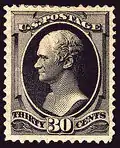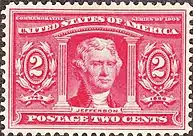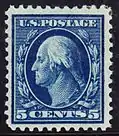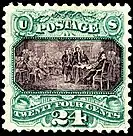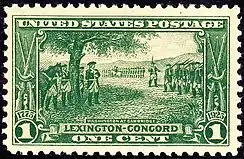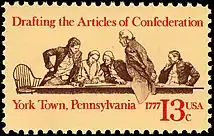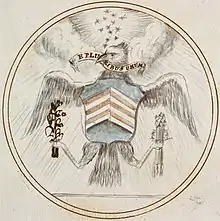Founding Fathers of the United States
The Founding Fathers of the United States, known simply as the Founding Fathers or Founders, were a group of late-18th-century American revolutionary leaders who united the Thirteen Colonies, oversaw the war for independence from Great Britain, established the United States of America, and crafted a framework of government for the new nation.
| Founding Fathers of the United States | |
|---|---|
| 1760s–1820s | |
%252C_by_John_Trumbull.jpg.webp) Declaration of Independence, an 1819 painting by John Trumbull, depicts the Committee of Five[lower-alpha 1] presenting their draft to the Second Continental Congress on June 28, 1776.[1] | |
| Location | The Thirteen Colonies, primarily those in the Northeastern USA |
| Including | Signers of the Declaration of Independence (1776), Articles of Confederation (1781), and United States Constitution (1789) |
| Leader(s) |
|
| Key events | |
| This article is part of a series on the |
| History of the United States |
|---|
 |
|
Historians generally recognize prominent leaders of the revolutionary era, such as George Washington, Benjamin Franklin, John Adams, Thomas Jefferson, and Alexander Hamilton, as Founding Fathers.[2] In addition, signers of the Declaration of Independence and the U.S. Constitution are widely credited with the nation's founding, while other scholars include all delegates to the Constitutional Convention whether they signed the Constitution or not.[3][4] Furthermore, some historians include signers of the Articles of Confederation, which was adopted as the nation's first constitution in 1781.[5]
Beyond this, the criteria for inclusion vary. Historians have singled out individuals ranging from military leaders during the Revolutionary War and participants in events before the war to prominent writers, orators, and other contributors to the American cause, including both men and women.[6][7][8][9] The debate has also shifted from the 19th-century concept of the Founders as demigods who created the modern nation-state to take into account contemporary concerns over the inability of the founding generation to remedy issues such as slavery and the treatment of Native Americans.[10][11] More recently, yet another approach has been suggested that recognizes the accomplishments as well as the shortcomings of the nation's founders by viewing them within the context of their times.[12]
Founding Father as a title
The exact phrase Founding Fathers was first coined by Senator Warren G. Harding in his keynote speech at the Republican National Convention in 1916.[13] Harding repeated the phrase at his own inauguration in 1921.[14] While presidents and others used the terms founders and fathers in their speeches throughout the 20th century, it was another sixty years before one would use Harding's phrase during the inaugural ceremonies. Ronald Reagan referred to "Founding Fathers" at both his first inauguration in 1981 and his second in 1985.[15][16] The term Founding Fathers has been widely used in histories of the founding era, beginning in 1941 with Kenneth Bernard Umbreit's Founding Fathers: Men Who Shaped Our Tradition.[17][7]
John Adams, in response to praise for his generation, rejoined, "I ought not to object to your reverence for your fathers ... but to tell you a very great secret, I have no reason to believe we were better than you are." He also wrote, "Don't call me, ... Father ... [or] Founder ... These titles belong to no man, but to the American people in general."[18]
In his second inaugural address (1805), Thomas Jefferson referred to those who first came to the New World as "forefathers".[19] At his 1825 inauguration, John Quincy Adams called the Constitution "the work of our forefathers" and expressed his gratitude to "founders of the Union".[20] In July of the following year, Quincy Adams, in an executive order upon the deaths of his father John Adams and Thomas Jefferson, paid tribute to the two as both "Fathers" and "Founders of the Republic".[21] These terms were used in the United States throughout the 19th century, from the inaugurations of Martin Van Buren and James Polk in 1837 and 1845, to Abraham Lincoln's Cooper Union speech in 1860 and his Gettysburg Address in 1863, and up to William McKinley's first inauguration in 1897.[22][23][24][25]
At a 1902 celebration of Washington's Birthday in Brooklyn, New York, the constitutional lawyer and later congressman, James M. Beck delivered an address titled "Founders of the Republic". In it, he connected the concepts of founders and fathers: "It is well for us to remember certain human aspects of the founders of the republic. Let me first refer to the fact that these fathers of the republic were for the most part young men." Beck included George Washington, Alexander Hamilton, Patrick Henry, John Jay, Thomas Jefferson, James Madison, and John Marshall in his pantheon of founders. He also credited the members of the Second Continental Congress who adopted the Declaration of Independence, mentioned John Hancock, Josiah Quincy, and Joseph Warren for their connections with the Boston Tea Party, and singled out Revolutionary War military leaders such as Nathanael Greene, Henry Knox, John Paul Jones, and "Mad Anthony" Wayne.[9]
Key founders

Historian Richard B. Morris identified seven figures as key Founding Fathers in his 1973 book Seven Who Shaped Our Destiny: The Founding Fathers as Revolutionaries. His selections, based on what Morris called the "triple tests" of leadership, longevity, and statesmanship, included John Adams, Benjamin Franklin, Alexander Hamilton, John Jay, Thomas Jefferson, James Madison, and George Washington.[27]
Morris's selection of seven "greats" has become widely accepted.[8][7] Adams, Jefferson, and Franklin were members of the Committee of Five that drafted the Declaration of Independence. The Federalist Papers, which advocated the ratification of the Constitution, were written by Hamilton, Madison, and Jay. The constitutions drafted by Jay and Adams for their respective states of New York (1777) and Massachusetts (1780) were heavily relied upon when creating language for the U.S. Constitution.[28][29][30] Franklin, Jay and Adams negotiated the 1783 Treaty of Paris that brought an end to the American Revolutionary War.[31]
Washington was Commander-in-Chief of the Continental Army and later president of the Constitutional Convention.[32][33] All held additional important roles in the early government of the United States, with Washington, Adams, Jefferson, and Madison serving as the first four presidents; Adams and Jefferson as the first two vice presidents;[34] Jay as the nation's first chief justice;[35] Hamilton as the first Secretary of the Treasury;[36] Jefferson and Madison as Secretaries of State;[37][38] and Franklin as America's most senior diplomat and later governor of Pennsylvania, for a term of three years.[39]
Framers and signers
.tif.jpg.webp)
The National Archives has identified three founding documents as the "Charters of Freedom": Declaration of Independence, United States Constitution, and Bill of Rights. According to the Archives, these documents "have secured the rights of the American people for more than two and a quarter centuries and are considered instrumental to the founding and philosophy of the United States."[40] In addition, as the nation's first constitution, the Articles of Confederation and Perpetual Union has also gained acceptance as a founding document.[41][42] As a result, signers of three key documents are generally considered to be Founding Fathers of the United States: Declaration of Independence (DI),[3] Articles of Confederation (AC),[5] and U.S. Constitution (USC).[4] The following table provides a list of these signers, some of whom signed more than one document.
| Name | Province/state | DI (1776) | AC (1777) | USC (1787) |
|---|---|---|---|---|
| Andrew Adams | Connecticut | Yes | ||
| John Adams | Massachusetts | Yes | ||
| Samuel Adams | Massachusetts | Yes | Yes | |
| Thomas Adams | Virginia | Yes | ||
| Abraham Baldwin | Georgia | Yes | ||
| John Banister | Virginia | Yes | ||
| Josiah Bartlett | New Hampshire | Yes | Yes | |
| Richard Bassett | Delaware | Yes | ||
| Gunning Bedford Jr. | Delaware | Yes | ||
| John Blair | Virginia | Yes | ||
| William Blount | North Carolina | Yes | ||
| Carter Braxton | Virginia | Yes | ||
| David Brearley | New Jersey | Yes | ||
| Jacob Broom | Delaware | Yes | ||
| Pierce Butler | South Carolina | Yes | ||
| Charles Carroll | Maryland | Yes | ||
| Daniel Carroll | Maryland | Yes | Yes | |
| Samuel Chase | Maryland | Yes | ||
| Abraham Clark | New Jersey | Yes | ||
| William Clingan | Pennsylvania | Yes | ||
| George Clymer | Pennsylvania | Yes | Yes | |
| John Collins | Rhode Island | Yes | ||
| Francis Dana | Massachusetts | Yes | ||
| Jonathan Dayton | New Jersey | Yes | ||
| John Dickinson | Delaware | Yes | Yes | |
| William Henry Drayton | South Carolina | Yes | ||
| James Duane | New York | Yes | ||
| William Duer | New York | Yes | ||
| William Ellery | Rhode Island | Yes | Yes | |
| William Few | Georgia | Yes | ||
| Thomas Fitzsimons | Pennsylvania | Yes | ||
| William Floyd | New York | Yes | ||
| Benjamin Franklin | Pennsylvania | Yes | Yes | |
| Elbridge Gerry | Massachusetts | Yes | Yes | |
| Nicholas Gilman | New Hampshire | Yes | ||
| Nathaniel Gorham | Massachusetts | Yes | ||
| Button Gwinnett | Georgia | Yes | ||
| Lyman Hall | Georgia | Yes | ||
| Alexander Hamilton | New York | Yes | ||
| John Hancock | Massachusetts | Yes | Yes | |
| John Hanson | Maryland | Yes | ||
| Cornelius Harnett | North Carolina | Yes | ||
| Benjamin Harrison | Virginia | Yes | ||
| John Hart | New Jersey | Yes | ||
| John Harvie | Virginia | Yes | ||
| Joseph Hewes | North Carolina | Yes | ||
| Thomas Heyward Jr. | South Carolina | Yes | Yes | |
| Samuel Holten | Massachusetts | Yes | ||
| William Hooper | North Carolina | Yes | ||
| Stephen Hopkins | Rhode Island | Yes | ||
| Francis Hopkinson | New Jersey | Yes | ||
| Titus Hosmer | Connecticut | Yes | ||
| Samuel Huntington | Connecticut | Yes | Yes | |
| Richard Hutson | South Carolina | Yes | ||
| Jared Ingersoll | Pennsylvania | Yes | ||
| William Jackson | South Carolina | Yes | ||
| Thomas Jefferson | Virginia | Yes | ||
| Daniel of St. Thomas Jenifer | Maryland | Yes | ||
| William Samuel Johnson | Connecticut | Yes | ||
| Rufus King | Massachusetts | Yes | ||
| John Langdon | New Hampshire | Yes | ||
| Edward Langworthy | Georgia | Yes | ||
| Henry Laurens | South Carolina | Yes | ||
| Francis Lightfoot Lee | Virginia | Yes | Yes | |
| Richard Henry Lee | Virginia | Yes | Yes | |
| Francis Lewis | New York | Yes | Yes | |
| Philip Livingston | New York | Yes | ||
| William Livingston | New Jersey | Yes | ||
| James Lovell | Massachusetts | Yes | ||
| Thomas Lynch Jr. | South Carolina | Yes | ||
| James Madison | Virginia | Yes | ||
| Henry Marchant | Rhode Island | Yes | ||
| John Mathews | South Carolina | Yes | ||
| James McHenry | Maryland | Yes | ||
| Thomas McKean | Delaware | Yes | Yes | |
| Arthur Middleton | South Carolina | Yes | ||
| Gouverneur Morris[lower-alpha 2] | New York | Yes | ||
| Pennsylvania | Yes | |||
| Thomas Mifflin | Pennsylvania | Yes | ||
| Lewis Morris | New York | Yes | ||
| Robert Morris | Pennsylvania | Yes | Yes | Yes |
| John Morton | Pennsylvania | Yes | ||
| Thomas Nelson Jr. | Virginia | Yes | ||
| William Paca | Maryland | Yes | ||
| Robert Treat Paine | Massachusetts | Yes | ||
| William Paterson | New Jersey | Yes | ||
| John Penn | North Carolina | Yes | Yes | |
| Charles Pinckney | South Carolina | Yes | ||
| Charles Cotesworth Pinckney | South Carolina | Yes | ||
| George Read | Delaware | Yes | Yes | |
| Joseph Reed | Pennsylvania | Yes | ||
| Daniel Roberdeau | Pennsylvania | Yes | ||
| Caesar Rodney | Delaware | Yes | ||
| George Ross | Pennsylvania | Yes | ||
| Benjamin Rush | Pennsylvania | Yes | ||
| Edward Rutledge | South Carolina | Yes | ||
| John Rutledge | South Carolina | Yes | ||
| Nathaniel Scudder | New Jersey | Yes | ||
| Roger Sherman | Connecticut | Yes | Yes | Yes |
| James Smith | Pennsylvania | Yes | ||
| Jonathan Bayard Smith | Pennsylvania | Yes | ||
| Richard Dobbs Spaight | North Carolina | Yes | ||
| Richard Stockton | New Jersey | Yes | ||
| Thomas Stone | Maryland | Yes | ||
| George Taylor | Pennsylvania | Yes | ||
| Edward Telfair | Georgia | Yes | ||
| Matthew Thornton | New Hampshire | Yes | ||
| Nicholas Van Dyke | Delaware | Yes | ||
| George Walton | Georgia | Yes | ||
| John Walton | Georgia | Yes | ||
| George Washington | Virginia | Yes | ||
| John Wentworth Jr. | New Hampshire | Yes | ||
| William Whipple | New Hampshire | Yes | ||
| John Williams | North Carolina | Yes | ||
| William Williams | Connecticut | Yes | ||
| Hugh Williamson | North Carolina | Yes | ||
| James Wilson | Pennsylvania | Yes | Yes | |
| John Witherspoon | New Jersey | Yes | Yes | |
| Oliver Wolcott | Connecticut | Yes | Yes | |
| George Wythe | Virginia | Yes |
Other delegates
The 55 delegates who attended the Constitutional Convention are referred to as framers. Of these, 16 failed to sign the document.[43] Three refused, while the remainder left early, either in protest of the proceedings or for personal reasons.[44][45] Nevertheless, some sources regard all framers as founders, including those who did not sign:[4][46]
- William Richardson Davie, North Carolina
- Oliver Ellsworth, Connecticut
- Elbridge Gerry, Massachusetts *
- William Houston, New Jersey
- William Houstoun, Georgia
- John Lansing, Jr., New York
- Alexander Martin, North Carolina
- Luther Martin, Maryland
- George Mason, Virginia *
- James McClurg, Virginia
- John Francis Mercer, Maryland
- William Pierce, Georgia
- Edmund Randolph, Virginia *
- Caleb Strong, Massachusetts
- George Wythe, Virginia
- Robert Yates, New York
(*) Randolph, Mason, and Gerry were the only three present at the Constitution's adoption who refused to sign.
Additional founders
In addition to the signers of the founding documents and the seven notable leaders previously mentioned—Adams, Franklin, Hamilton, Jay, Jefferson, Madison, and Washington—the following are regarded as founders based on their contributions to the birth and early development of the new nation:
- Ethan Allen, military leader and founder of Vermont.[47][48]
- George Clinton, first governor of New York, 1777–1795, and fourth vice president of the U.S., 1805–1812.[48]
- Patrick Henry, gifted orator, known for his famous quote, "Give me liberty, or give me death!",[49] served in the First Continental Congress in 1774 and briefly in the Second Congress in 1775 before returning to Virginia to lead its militia. He then held one-year terms as the first and sixth governor of Virginia, 1776–1779 and 1784–1786.[50] Henry and Sam Adams were considered the most outspoken anti-federalists in opposing ratification of the Constitution, though neither participated in the Convention.[51]
- Henry Knox served as chief artillery officer in most of Washington's campaigns. His earliest achievement was the capture of over 50 pieces of artillery, primarily cannons, at New York's Fort Ticonderoga, one of the keys to Washington's capture of Boston in early 1776. Knox became the first Secretary of War under the U.S. Constitution in 1789.[9]
- Robert R. Livingston, member of the Committee of Five that drafted the Declaration of Independence, 1776; first U.S. Secretary of Foreign Affairs, 1781–1783, and first Chancellor of New York, 1777–1801. He administered the presidential oath of office at the First inauguration of George Washington and with James Monroe negotiated the Louisiana Purchase as the minister to France.[52][53]
- John Marshall, fourth chief justice of the U.S. Supreme Court, 1801–1835.[54][55]
- James Monroe, elected to the Virginia legislature (1782); member of the Second Continental Congress (1783–1786);[56] fifth president of the United States for two terms (1817–1825);[57] Negotiated the Louisiana Purchase along with Robert Livingston.[58]
- Thomas Paine, author of Common Sense and other influential pamphlets in the 1770s; sometimes referred to as "Father of the American Revolution".[54][59][60] While John Adams strongly criticized Paine for failing to see the need for a separation of powers in government, Common Sense proved crucial in building support for independence following its publication in January 1776.[61][62]
- Peyton Randolph, speaker of Virginia's House of Burgesses, president of the First Continental Congress, and a signer of the Continental Association.[63]
- Paul Revere, silversmith, member of the Sons of Liberty which staged the Boston Tea Party, and one of two horsemen in the midnight ride.[54][64]
- Charles Thomson, secretary of the Continental Congress from its formation to its final session, 1774–1789.[65]
- Joseph Warren, respected physician and architect of the Revolutionary movement, known as the "Founding Martyr" for his death at the Battle of Bunker Hill, drafted the Suffolk Resolves in response to the Intolerable Acts.[66]
- "Mad Anthony" Wayne, a prominent army general during the Revolutionary War.[67][54]
Women
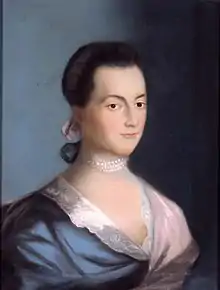
Historians also have come to recognize the roles women played in the nation's early development, using the term "Founding Mothers".[68][69] Among the females honored in this respect are:
- Abigail Adams, wife, confidant, and advisor to John Adams, as well as second First Lady; mother of sixth U.S. president John Quincy Adams; famously extolled her husband to "remember the ladies" in shaping the new nation.[48][64][70]
- Dolley Madison, wife of fourth U.S. president James Madison; regarded as the most important First Lady of the 19th century, 1809–1817.[71][72]
- Mercy Otis Warren, poet, playwright, and pamphleteer during the American Revolution.[54][73]
Selected portraits of Founding Fathers | ||||||||||||||||
|---|---|---|---|---|---|---|---|---|---|---|---|---|---|---|---|---|
|
Other patriots
The following men and women also advanced the new nation through their actions, but are not necessarily regarded as founders:
- Richard Allen, African-American bishop, founder of the Free African Society and the African Methodist Episcopal Church[78]
- Crispus Attucks, believed to be of Native American and African descent, the first person killed in the Boston Massacre of 1770 and thus the first to die in the American Revolution.[79] Of the deaths at Boston John Adams would later write, "On that night the foundations of American independence was laid."[80]
- John Bartram, botanist, horticulturist, and explorer[81]
- Israel Bissell, a patriot post rider in Massachusetts who rode the news to Philadelphia of the British attack on Lexington and Concord.
- Elias Boudinot, New Jersey delegate to Continental Congress[82]
- Aaron Burr, vice president under Jefferson[83]
- Cato, a Black Patriot and slave who served as a spy alongside his owner, Hercules Mulligan. Cato carried intelligence gathered by Mulligan to officers in the Continental Army and other revolutionaries, including through British-held territory, which was credited for likely saving George Washington's life on at least two occasions. He was granted his freedom in 1778 for his service.[84]
- Angelica Schuyler Church, sister-in-law of Alexander Hamilton, corresponded with many of the leading Founding Fathers, including Thomas Jefferson, Alexander Hamilton, and the Marquis de Lafayette.[85]
- George Rogers Clark, army general, nicknamed "Conqueror of the Old Northwest".[86]
- Tench Coxe, economist in the Continental Congress[87]
- Albert Gallatin, politician and treasury secretary[88]
- Horatio Gates, army general. Present at the Battle of Saratoga, whose victory was the turning point of the Revolutionary War[67]
- Nathanael Greene, Revolutionary War general; commanded the southern theater[67]
- Nathan Hale, captured U.S. soldier, executed in 1776 for spying on British in New York[89]
- Elizabeth Schuyler Hamilton, wife of Alexander Hamilton[90][91]
- Esek Hopkins, Commander-in-Chief of the Continental Navy[92]
- James Iredell, essayist for independence and advocate for the constitution, one of the first Supreme Court justices[54]
- John Paul Jones, U.S. navy captain. Commander of USS Bonhomme Richard; when asked to surrender by the British he uttered his famous cry, "I have not yet begun to fight".[67][93]
- Tadeusz Kościuszko, American general, former Polish army general[88]
- Bernardo de Galvez, Spanish military, governor of Spanish Louisiana. Captured Baton Rouge, Natchez, and Mobile, all in British West Florida.[94]
- Gilbert du Motier, Marquis de Lafayette, French Marquis who became a Continental Army general.[95] Served without pay, brought a ship to America, outfitted for war, provided clothing and other provisions for the patriot cause, all at his own expense.[96]
- John Laurance, New York politician and judge who served as Judge advocate general during the Revolution.[97]
- Henry Lee III, army officer and Virginia governor[67]
- William Maclay, Pennsylvania politician and U.S. senator[54]
- Philip Mazzei, Italian physician, merchant, and author[98]
- Daniel Morgan, military leader and Virginia congressman[67]
- Hercules Mulligan, Irish-American tailor and spy, member of the Sons of Liberty.[99] Introduced Alexander Hamilton into New York society and helped him recruit men for his artillery units.[100]
- Samuel Nicholas, commander-in-chief of the Continental Marines[101]
- James Otis Jr., one of the earliest proponents of patriotic causes, an opponent of slavery, and leader of Massachusetts' Committee of Correspondence, all in the 1760s.[102][103]
- Andrew Pickens, army general and South Carolina congressman[67]
- Timothy Pickering, Secretary of War, U.S. secretary of state, from Massachusetts. Fired by President John Adams; replaced by John Marshall.[104]
- Oliver Pollock, a merchant, diplomat, and financier of the American Revolutionary War
- Israel Putnam, army general[105]
- Jean-Baptiste Donatien de Vimeur, comte de Rochambeau, French army general[88]
- John Rogers, Maryland lawyer and judge, delegate to the Continental Congress who voted for the Declaration of Independence but fell ill before he could sign it.[106]
- Philip Schuyler, Revolutionary War general, U.S. senator from New York, father of the Schuyler sisters.
- Haym Solomon, financier and spy for the Continental Army[107]
- Arthur St. Clair, major general, president of the Confederation Congress, and later first governor of the Northwest Territory
- Thomas Sumter, South Carolina military leader, and member of both houses of Congress[67]
- Richard Varick, private secretary to George Washington, recorder of New York City (1786); Speaker of the New York Assembly (1787); second attorney general of New York state (1788–1789); Mayor of New York City (1789–1801); founder of the American Bible Society (1828) [108]
- Friedrich Wilhelm von Steuben, Prussian officer;[88] Inspector General of Continental Army; Present at Valley forge with Washington, training militia.[109]
- Noah Webster, political writer, lexicographer, educator. Author of the first English Dictionary containing numerous references to Washington and the revolution.[110]
- Thomas Willing, delegate to the Continental Congress from Pennsylvania, the first president of the Bank of North America, and the first president of the First Bank of the United States[111]
- Henry Wisner, New York Continental Congress delegate who voted for the Declaration of Independence but left Philadelphia before the signing.
The colonies unite (1765–1774)
In the mid-1760s, Parliament began levying taxes on the colonies to finance Britain's debts from the French and Indian War, a decade-long conflict that ended in 1763.[112][113] Opposition to Stamp Act and Townshend Acts united the colonies in a common cause.[114] While the Stamp Act was withdrawn, taxes on tea remained under the Townshend Acts and took on a new form in 1773 with Parliament's adoption of the Tea Act. The new tea tax, along with stricter customs enforcement, was not well-received across the colonies, particularly in Massachusetts.[115]
On December 16, 1773, 150 colonists disguised as Mohawk Indians, boarded ships in Boston and dumped 342 chests of tea into the city's harbor, a protest that came to be known as the Boston Tea Party.[116][117] Orchestrated by Samuel Adams and the Boston Committee of Correspondence, the protest was viewed as treasonous by British authorities.[118] In response, Parliament passed the Coercive or Intolerable Acts, a series of punitive laws that closed Boston's port and placed the colony under direct control of the British government. These measures stirred unrest throughout the colonies, which felt Parliament had overreached its authority and was posing a threat to the self-rule that had existed in the Americas since the 1600s.[115]
Intent on responding to the Acts, twelve of the Thirteen Colonies agreed to send delegates to meet in Philadelphia as the First Continental Congress, with Georgia declining because it needed British military support in its conflict with native tribes.[119] The concept of an American union had been entertained long before 1774, but always embraced the idea that it would be subject to the authority of the British Empire. By 1774, however, letters published in colonial newspapers, mostly by anonymous writers, began asserting the need for a "Congress" to represent all Americans, one that would have equal status with British authority.[120]
Continental Congress (1774–1775)
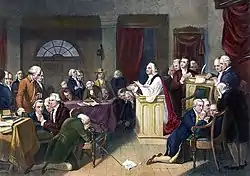
by T. H. Matteson, 1848
The Continental Congress was brought together to deal with a series of pressing issues the colonies were facing with Britain. Its delegates were men considered to be the most intelligent and thoughtful among the colonialists. In the wake of the Intolerable Acts, at the hands of an unyielding British King and Parliament, the colonies were forced to choose between either totally submitting to arbitrary Parliamentary authority or resorting to unified armed resistance.[121][122] The new Congress functioned as the directing body in declaring a great war, and was sanctioned only by reason of the guidance it provided during the armed struggle. Its authority remained ill defined, and few of its delegates realized that events would soon lead them to deciding policies that ultimately established a "new power among the nations". In the process the Congress performed many experiments in government before an adequate Constitution evolved.[123][124]
First Continental Congress (1774)
The First Continental Congress convened at Philadelphia's Carpenter's Hall on September 5, 1774.[125] The Congress, which had no legal authority to raise taxes or call on colonial militias, consisted of 56 delegates, including George Washington of Virginia; John Adams and Samuel Adams of Massachusetts; John Jay of New York; John Dickinson of Pennsylvania; and Roger Sherman of Connecticut. Peyton Randolph of Virginia was unanimously elected its first president.[75][126]
The Congress came close to disbanding in its first few days over the issue of representation, with smaller colonies desiring equality with the larger ones. While Patrick Henry, from the largest colony, Virginia, disagreed, he stressed the greater importance of uniting the colonies: "The distinctions between Virginians, Pennsylvanians, New Yorkers, and New Englanders are no more. I am not a Virginian, but an American!".[127] The delegates then began with a discussion of the Suffolk Resolves, which had just been approved at a town meeting in Milton, Massachusetts.[128] Joseph Warren, chairman of the Resolves drafting committee, had dispatched Paul Revere to deliver signed copies to the Congress in Philadelphia.[129][130][118] The Resolves called for the ouster of British officials, a trade embargo of British goods, and the formation of a militia throughout the colonies.[128] Despite the radical nature of the resolves, on September 17 the Congress passed them in their entirety in exchange for assurances that Massachusetts' colonists would do nothing to provoke war.[131][132]
The delegates then approved a series of measures, including a Petition to the King in an appeal for peace and a Declaration and Resolves which introduced the ideas of natural law and natural rights, foreshadowing some of the principles found in the Declaration of Independence and Bill of Rights.[133] The declaration asserted the rights of colonists and outlined Parliament's abuses of power. Proposed by Richard Henry Lee, it also included a trade boycott known as the Continental Association.[134] The Association, a crucial step toward unification, empowered committees of correspondence throughout the colonies to enforce the boycott. The Declaration and its boycott directly challenged Parliament's right to govern in the Americas, bolstering the view of King George III and his administration under Lord North that the colonies were in a state of rebellion.[135]
Lord Dartmouth, the Secretary of State for the Colonies who had been sympathetic to the Americans, condemned the newly established Congress for what he considered its illegal formation and actions.[136][137] In tandem with the Intolerable Acts, British Army commander-in-chief Lieutenant General Thomas Gage was installed as governor of Massachusetts. In January 1775, Gage's superior, Lord Dartmouth, ordered the general to arrest those responsible for the Tea Party and to seize the munitions that had been stockpiled by militia forces outside of Boston. The letter took several months to reach Gage, who acted immediately by sending out 700 army regulars.[138] During their march to Lexington and Concord on the morning of April 19, 1775, the British troops encountered militia forces, who had been warned the night before by Paul Revere and another messenger on horseback, William Dawes. Even though it is unknown who fired the first shot, battles broke out and the Revolutionary War began.[139]
Second Continental Congress (1775)

On May 10, 1775, less than three weeks after the Battles at Lexington and Concord, the Second Continental Congress convened in the Pennsylvania State House. The gathering essentially reconstituted the First Congress with many of the same delegates in attendance.[140] Among the new arrivals were Benjamin Franklin of Pennsylvania, John Hancock of Massachusetts, and in June, Thomas Jefferson of Virginia. Hancock was elected president two weeks into the session when Peyton Randolph was recalled to Virginia to preside over the House of Burgesses as speaker, and Jefferson was named to replace him in the Virginia delegation.[141] After adopting the rules of debate from the previous year and reinforcing its emphasis on secrecy,[142][143] the Congress turned to its foremost concern, the defense of the colonies.[144]
The provincial assembly in Massachusetts, which had declared the colony's governorship vacant, reached out to the Congress for direction on two matters: whether the assembly could assume the powers of civil government and whether the Congress would take over the army being formed in Boston.[145] In answer to the first question, on June 9 the colony's leaders were directed to chose a council to govern within the spirit of the colony's charter.[146][147] As for the second, Congress spent several days discussing plans for guiding the forces of all thirteen colonies. Finally, on June 14 Congress approved provisioning the New England militias, agreed to send ten companies of riflemen from other colonies as reinforcements, and appointed a committee to draft rules for governing the military, thus establishing the Continental Army. The next day, Samuel and John Adams nominated Washington as commander-in-chief, a motion that was unanimously approved.[148][149] Two days later, on June 17, the militias clashed with British forces at Bunker Hill, a victory for Britain but a costly one.[150]
The Congress's actions came despite the divide between conservatives who still hoped for reconciliation with England and at the other end of the spectrum, those who favored independence.[151] To satisfy the former, Congress adopted the Olive Branch Petition on July 5, an appeal for peace to King George III written by John Dickinson. Then, the following day, it approved the Declaration of the Causes and Necessity of Taking Up Arms, a resolution justifying military action.[148] The declaration, intended for Washington to read to the troops upon his arrival in Massachusetts, was drafted by Jefferson but edited by Dickinson who thought its language too strong.[152][153] When the Olive Branch Petition arrived in London in September, the king refused to look at it.[154] By then, he had already issued a proclamation declaring the American colonies in rebellion.[155]
Declaration of Independence (1776)
Under the auspices of the Second Continental Congress and its Committee of Five,[156] Thomas Jefferson drafted the Declaration of Independence. It was presented to the Congress by the Committee on June 28,[157] and after much debate and editing of the document, on July 2, 1776,[158][159] Congress passed the Lee Resolution, which declared the United Colonies independent from Great Britain. Two days later, on July 4, the Declaration of Independence was adopted.[160] The name "United States of America", which first appeared in the Declaration, was formally approved by the Congress on September 9, 1776.[161]
In an effort to get this important document promptly into the public realm John Hancock, president of the Second Continental Congress, commissioned John Dunlap, editor and printer of the Pennsylvania Packet, to print 200 broadside copies of the Declaration, which came to be known as the Dunlap broadsides. Printing commenced the day after the Declaration was adopted. They were distributed throughout the 13 colonies/states with copies sent to General Washington and his troops at New York with a directive that it be read aloud. Copies were also sent to Britain and other points in Europe.[162][163][157]
Fighting for independence

While the colonists were fighting the British to gain independence their newly formed government, with its Articles of Confederation, were put to the test, revealing the shortcomings and weaknesses of America's first Constitution. During this time Washington became convinced that a strong federal government was urgently needed, as the individual states were not meeting the organizational and supply demands of the war on their own individual accord.[164][165] Key precipitating events included the Boston Tea Party in 1773, Paul Revere's Ride in 1775, and the Battles of Lexington and Concord in 1775.[166] George Washington's crossing of the Delaware River was a major American victory over Hessian forces at the Battle of Trenton and greatly boosted American morale.[167] The Battle of Saratoga and the Siege of Yorktown, which primarily ended the fighting between American and British, were also pivotal events during the war. The 1783 Treaty of Paris marked the official end of the war.[168]
After the war Washington was instrumental in organizing the effort to create a "national militia" made up of individual state units, and under the direction of the Federal government. He also endorsed the creation of a military academy to train artillery offices and engineers. Not wanting to leave the country disarmed and vulnerable so soon after the war, Washington favored a peacetime army of 2600 men. He also favored the creation of a navy that could repel any European intruders. He approached Henry Knox, who accompanied Washington during most of his campaigns, with the prospect of becoming the future Secretary of War.[169]
Treaty of Paris
.jpg.webp)
After Washington's final victory at the surrender at Yorktown on October 19, 1781, more than a year passed before official negotiations for peace commenced and ultimately a treaty was adopted. The Treaty of Paris was drafted in November 1782, and negotiations began in April 1783, continued through the summer, and the completed treaty was signed on September 3. Benjamin Franklin, John Adams, John Jay and Henry Laurens represented the United States,[170] and David Hartley, a member of Parliament, and Richard Oswald, a prominent and influential Scotish businessman,[171] represented Great Britain.[172] While in France, Franklin, who had a long established rapport with the French, and was almost entirely responsible for securing an alliance with them during the war, was greeted with high honors from the French council, while the others received due accommodations but were generally considered to be amateur negotiators.[173] Communications between Britain and France was largely effected through Franklin and Lord Shelburne who was on good terms with Franklin.[174] Franklin, Adams and Jay understood the concerns of the French at this uncertain juncture and, using that to their advantage, in the final sessions of negotiations convinced both the French and the British that American independence was in their best interests.[175]
Constitutional Convention

In the winter and spring of 1786–87, 12 of the 13 states chose 74 delegates to attend the Constitutional Convention in Philadelphia. Nineteen delegates chose not to accept election or attend the debates. Among them was Henry, who in response to questions about his refusal to attend replied, "I smelled a rat." He believed that the frame of government the convention organizers were intent on building would trample upon citizens' rights.[176]
The Constitutional Convention took place from May 25 to September 17, 1787, in Philadelphia.[177] The delegates elected George Washington, whom they all trusted, to preside over the convention.[178] Although the convention was called to revise the Articles of Confederation, the intention from the outset for some, including James Madison and Alexander Hamilton, was to create a new framework of government rather than amend the existing one.[178]
The 55 delegates attending the Constitutional Convention were a group of distinguished men who represented a cross-section of 18th-century American leadership. Nearly all were well-educated and prominent in their respective states. Nearly all were involved in the revolution and its war, with at least 29 serving in the Continental Army. The group in its entirety had extensive political experience; 41 of the delegates were or had been members of the Continental Congress.[179]
Because they were about to make major changes to the form of government rather than amend the existing one, which was deemed something that would prove controversial and impeding, the delegates to the convention were sworn to secrecy and conducted the business of ratification behind closed doors.[180][181] As such, Madison's notes on the ratification were not published until after his death in 1836.[182]
The result of the convention was the United States Constitution. After four months of debate, the Constitution was ratified and adopted on September 17, 1787.[177] After it had been adopted, Madison maintained that it was Washington's influence that brought overall acceptance of the Constitution.[183] On April 6, 1789, under the new Constitution, the Senate oversaw the counting of a total of 69 ballots that unanimously elected Washington as the first president of the United States, with 34 ballots that elected John Adams as the nation's first vice president.[184]
Rhode Island's lack of representation at the convention was the result of suspicions of the convention delegates' motivations. As Rhode Island was founded by Roger Williams as a sanctuary for Baptists, its absence at the convention in part explains the absence of Baptist affiliation among those who attended. Of the 55 delegates who attended at some point, no more than 38 showed up at one time.[185] After the Constitution was ratified, Madison advised President Washington on various important decisions and legislation that placed the young nation on a stable foundation.[186]
Religious freedom
Religious persecution had existed for centuries around the world and it existed in colonial America.[187] Founders such as Thomas Jefferson, James Madison, Patrick Henry and James Mason first established a measure of religious freedom in Virginia in 1776 with the Virginia Declaration of Rights, which became the model for religious liberty for the nation.[188] The Baptists, Presbyterians and the Lutherans had been for a decade prior petitioning against the established church of England for religious liberties. Jefferson had left the Continental Congress to return to Virginia to join the fight for religious freedom, which proved difficult, as many members of the Virginia legislature belonged to the established church. While he was not completely successful, Jefferson managed to have the laws which punished those with different religious beliefs repealed.[188][189][190] Jefferson was also the architect for separation of Church and State, was opposed to the use of public funds to support the established church and thought it unwise to link civil rights to religious doctrine.[191][190] Freedom of religion, along with freedom of speech, ultimately became the law of the nation. The first statement in the First Amendment to the U.S. Constitution proclaims the right to Freedom of Religion, and became part of the Bill of Rights which was adopted in 1791.[187]
Bill of Rights
The Constitution, as drafted, was sharply criticized by the Anti-Federalists, a group that contended the document failed to safeguard individual liberties from the federal government. Leading Anti-Federalists included Patrick Henry and Richard Henry Lee, both from Virginia, and Samuel Adams of Massachusetts. Delegates at the Constitutional Convention who shared their views were Virginians George Mason and Edmund Randolph and Massachusetts representative Elbridge Gerry, all of whom refused to sign the final document.[192] Henry, who derived his hatred of a central governing authority from his Scottish ancestry, did all in his power to defeat the Constitution, opposing Madison every step of the way.[193]
The criticisms are what led to the amendments proposed under the Bill of Rights. Madison, the bill's principal author, was originally opposed to the amendments, but was influenced by the 1776 Virginia Declaration of Rights, primarily written by Mason, and the Declaration of Independence, by Thomas Jefferson.[194] Jefferson, while in France, shared Henry's and Mason's fears about a strong central government, especially the president's power, but because of his friendship with Madison and the pending Bill of Rights, he quieted his concerns.[195] Alexander Hamilton, however, was opposed to a Bill of Rights believing the amendments not only unnecessary but dangerous:
Why declare things shall not be done, which there is no power to do ... that the liberty of the press shall not be restrained, when no power is given by which restrictions may be imposed?[196]
Madison had no way of knowing the debate between Virginia's two legislative houses would delay the adoption of the amendments for more than two years.[197] The final draft, referred to the states by the federal Congress on September 25, 1789,[198] was not ratified by Virginia's Senate until December 15, 1791.[197]
The Bill of Rights drew its authority from the consent of the people and held that,
The enumeration in the Constitution, of certain rights, shall not be construed to deny or disparage others retained by the people.
— Article 11.
The powers not delegated to the United States by the Constitution, nor prohibited by it to the States, are reserved to the States respectively, or to the people.
— Article 12.[199]
Madison came to be recognized as the founding era's foremost proponent of religious liberty, free speech, and freedom of the press.[200]
Ascending to the presidency
The first five U.S. presidents are regarded as Founding Fathers and for their active participation in the American Revolution: Washington, John Adams, Jefferson, Madison, and Monroe. They all previously served as delegates in the Continental Congress.[201]
 George Washington (1789–1797)
George Washington (1789–1797) John Adams (1797–1801)
John Adams (1797–1801)(cropped).jpg.webp) Thomas Jefferson (1801–1809)
Thomas Jefferson (1801–1809)(c).jpg.webp) James Madison (1809–1817)
James Madison (1809–1817) James Monroe (1817–1825)
James Monroe (1817–1825)
Demographics and other characteristics
The Founding Fathers represented the upper echelon of political leadership in the British colonies during the latter half of the 18th century.[202][203] All were leaders in their communities and respective colonies who were willing to assume responsibility for public affairs.[204]
Of the signers of the Declaration of Independence, Articles of Confederation, and U.S. Constitution, nearly all were native born and of British heritage, including Scots, Irish, and Welsh.[205][206] Nearly half were lawyers, while the remainder were primarily businessmen and planter-farmers.[207][208][209] The average age of the founders was 43.[210] Benjamin Franklin, born in 1706, was the oldest, while only a few were born after 1750 and thus were in their 20s.[211][212][213]
The following sections discuss these and other demographic topics in greater detail. For the most part, the information is confined to signers/delegates associated with the Declaration of Independence, Articles of Confederation, and Constitution.
Political experience
All of the Founding Fathers had extensive political experience at the national and state levels.[214][215] As just one example, the signers of the Declaration of Independence and Articles of Confederation were members of Second Continental Congress, while four-fifths of the delegates at the Constitutional Convention had served in the Congress either during or prior to the convention. The remaining fifth attending the convention were recognized as leaders in the state assemblies that appointed them.
Following are brief profiles of the political backgrounds of some of the more notable founders:
- John Adams began his political career as a town council member in Braintree outside Boston. He came to wider attention following a series of essays he wrote during the Stamp Act crisis of 1765. In 1770, he was elected to the Massachusetts General Assembly, went on to lead Boston's Committee of Correspondence, and in 1774, was elected to the Continental Congress. Two decades later, Adams would become the second president of the nation he helped found.[216][217]
- John Dickinson was one of the leaders of the Pennsylvania Assembly during the 1770s. As a member of the First and Second Continental Congress, he wrote two petitions for the Congress to King George III seeking a peaceful solution. Dickinson opposed independence and refused to sign the Declaration of Independence, but served as an officer in the militia and wrote the initial draft of the Articles of Confederation. In the 1780s, he served as president of Pennsylvania and president of Delaware[218]
- Benjamin Franklin retired from his business activities in 1747 and was elected to the Pennsylvania Assembly in 1751. He was sent to London in 1757 for the first of two diplomatic missions on behalf of the colony.[219] Upon returning from England in 1775, Franklin was elected to the Second Continental Congress. After signing the Declaration of Independence in 1776, he was appointed Minister to France and then Sweden, and in 1783 helped negotiate the Treaty of Paris. Franklin was governor of Pennsylvania from 1785 to 1788 and was a delegate to the Constitutional Convention.[220]
- John Jay was a New York delegate to the First and Second Continental Congress and in 1778 was elected Congress president. In 1782, he was summoned to Paris by Franklin to help negotiate the Treaty of Paris with Great Britain. As a supporter of the proposed Constitution, he wrote five of the Federalist Papers and became the first Chief Justice of the Supreme Court following the Constitution's adoption.[221] Minister to Spain[222] .[223][224]
- Thomas Jefferson was a delegate from Virginia to the Second Continental Congress (1775–1776) and was the primary author of the Declaration of Independence. He was elected the [List of governors of Virginia|second governor of Virginia] (1779–1781) and served as Minister to France (1785–1789).[225][226]
- Robert Morris had been a member of the Pennsylvania Assembly and president of Pennsylvania's Committee of Safety. He was also a member of the Committee of Secret Correspondence and member of the Second Continental Congress.[227]
- Roger Sherman had served in the First and Second Continental Congresses, Connecticut House of Representatives and Justice of the Peace.[228]
Education
More than a third of the Founding Fathers attended or graduated from colleges in the American colonies, while additional founders attended college abroad, primarily in England and Scotland. All other founders either were home schooled, received tutoring, completed apprenticeships, or were self-educated.
American colleges
Following is a listing of founders who graduated from the six colleges in the Americas during the Colonial Era. A few founders, such as Alexander Hamilton[229] and James Monroe,[230] attended college but did not graduate.
- College of William & Mary: Thomas Jefferson,[231] John Blair, Jr.,[232] James McClurg,[233] James Francis Mercer,[234] Edmund Randolph,[235]
- Columbia University (originally King's College): John Jay,[236] Robert R. Livingston,[237] Gouverneur Morris,[238]
- Harvard University (originally Harvard College): John Adams,[239] Samuel Adams,[240] Francis Dana,[241] William Ellery,[242] Elbridge Gerry,[243] John Hancock,[244] William Hooper,[245] William Samuel Johnson (also Yale),[246] Rufus King,[247] James Lovell,[248] Robert Treat Paine,[249] Caleb Strong,[250] Joseph Warren,[251] John Wentworth Jr.,[252] William Williams.[253]
- Princeton University (originally The College of New Jersey):[254] Gunning Bedford, Jr.,[255] David Brearley,[256] William Richardson Davie,[257] Jonathan Dayton,[258] Oliver Ellsworth,[259] Joseph Hewes,[260] William Houstoun,[261] Richard Hutson,[262] James Madison,[263] Alexander Martin,[264] Luther Martin,[265] William Paterson,[266] Joseph Reed,[267] Benjamin Rush,[268] Nathaniel Scudder,[269] Jonathan Bayard Smith,[270] Richard Stockton[271]
- University of Pennsylvania (originally College of Philadelphia): Francis Hopkinson,[272] Henry Marchant,[273] Thomas Mifflin,[274] William Paca,[275] Hugh Williamson[276]
- Yale University (originally Yale College): Andrew Adams,[277] Abraham Baldwin,[278] Lyman Hall,[279] Titus Hosmer,[280] Jared Ingersoll,[281] William Samuel Johnson (also Harvard),[246] Philip Livingston,[282] William Livingston,[283] Lewis Morris,[284] Oliver Wolcott[285]
United Kingdom colleges
Following are founders who graduated from colleges in Great Britain:
- Inner Temple, is one of the four Inns of Court in London offering legal studies for admission to the English Bar. William Houstoun,[286] William Paca (also University of Pennsylvania graduate) [287][275]
- Middle Temple, also one of the four Inns of Court: John Banister,[288] John Blair,[289] John Dickinson,[290] Thomas Heyward, Jr.,[291] Thomas Lynch, Jr. (also University of Cambridge graduate),[291] John Matthews,[292] Charles Cotesworth Pinckney,[293] Peyton Randolph,[294][295] John Rutledge[293]
- University of Cambridge, England: Thomas Lynch, Jr. (also Middle Temple graduate),[296] Thomas Nelson, Jr.[297]
- University of Edinburgh, Scotland: John Witherspoon[298]
Ethnicity
The greater majority of founders were natives of the American Colonies, while just nineteen were born in other parts of the British Empire.
- England: William Richardson Davie,[299] William Duer,[300] Button Gwinnett,[301] Robert Morris,[302] Thomas Paine,[303]
- Ireland: Pierce Butler,[304] Thomas Fitzsimons,[305] James McHenry,[306] William Paterson,[307] James Smith,[308] George Taylor,[309] Charles Thomson,[310] Matthew Thornton[311]
- Wales: Francis Lewis[315]
Occupations
While the Founding Fathers were engaged in a broad range of occupations, the greater majority had careers in three professions: about half the founders were lawyers, a sixth were planters/farmers, another sixth were merchants/businessmen, and the others were spread across miscellaneous professions.
- Ten founders were physicians: Josiah Bartlett,[318] Lyman Hall,[278] Samuel Holten,[319] James McClurg,[233] James McHenry (surgeon),[320] Benjamin Rush,[268] Nathaniel Scudder,[269] Matthew Thornton,[321] Joseph Warren,[251] and Hugh Williamson.[276]
- John Witherspoon was the only minister, although Lyman Hall had been a preacher prior to becoming a physician.[322][278]
- George Washington, a Virginia planter, was a land surveyor before becoming a colonel in the Virginia Regiment.[323]
- Benjamin Franklin was a successful printer and publisher and an accomplished scientist and inventor, in Philadelphia. Franklin retired at age 42 to focus first on scientific pursuits and then politics and diplomacy, serving as a member of the Continental Congress, first postmaster general, minister to Great Britain, France, and Sweden, and governor of Pennsylvania.[324][325][326][327]
Religion
Of the 55 delegates to the 1787 Constitutional Convention, 28 were Anglicans (i.e. Church of England; or Episcopalian, after the American Revolutionary War was won), 21 were other Protestant, and two were Roman Catholic (Daniel Carroll and Fitzsimons; Charles Carroll was Roman Catholic but was not a Constitution signatory).[328] Among the Protestant delegates to the Constitutional Convention, eight were Presbyterians, seven were Congregationalists, two were Lutherans, two were Dutch Reformed, and two were Methodists.[328] A few prominent Founding Fathers were anti-clerical, notably Jefferson.[329][330] Historian Gregg L. Frazer argues that the leading Founders (John Adams, Jefferson, Franklin, Wilson, Morris, Madison, Hamilton, and Washington) were neither Christians nor Deists, but rather supporters of a hybrid "theistic rationalism".[331] Many Founders deliberately avoided public discussion of their faith. Historian David L. Holmes uses evidence gleaned from letters, government documents, and second-hand accounts to identify their religious beliefs.[82]
Founders on currency and postage
Four U.S. Founders are minted on American currency—Benjamin Franklin, Alexander Hamilton, Thomas Jefferson, and George Washington; Washington and Jefferson both appear on three different denominations.
| Founding Father name | Currency image | Denomination |
|---|---|---|
| George Washington | 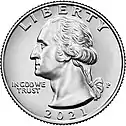 |
Quarter dollar (quarter) 25¢ |
 |
Dollar coin $1 | |
 |
One dollar $1 | |
| Thomas Jefferson |  |
Five cents (nickel) 5¢ |
 |
Dollar coin $1 | |
 |
Two dollars $2 | |
| Alexander Hamilton | 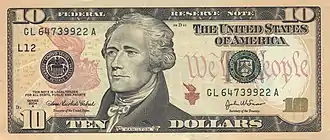 |
Ten dollars $10 |
| Benjamin Franklin |  |
One hundred dollars $100 |
1917 issue
Cultural impact (1843–present)
Holidays

Independence Day (colloquially called the Fourth of July) is a United States national holiday celebrated yearly on July 4 to commemorate the signing of the Declaration of Independence and the founding of the nation. Washington's Birthday is also observed as a national federal holiday, and is also known as Presidents' Day.
Institutions
Several Founding Fathers were instrumental in establishing schools and societal institutions that still exist today:
- Franklin founded the University of Pennsylvania,[332] while Jefferson founded the University of Virginia.[333]
- Washington supported the founding of Washington College by consenting to have the "College at Chester" named in his honor, through generous financial support, and through service on the college's Board of Visitors and Governors.
- Rush founded Dickinson College[334] and Franklin College, (today Franklin & Marshall College) as well as the College of Physicians of Philadelphia, the oldest medical society in America.
- Hamilton founded the New York Post, The Bank of New York,[335] Hamilton-Oneida Academy (now Hamilton College),[336] as well as what would become the United States Coast Guard.[337]
Media and theater
The Founding Fathers were portrayed in the Tony Award–winning 1969 musical 1776, which depicted the debates over, and eventual adoption of, the Declaration of Independence. The stage production was adapted into the 1972 film of the same name. The 1989 film A More Perfect Union, which was filmed on location in Independence Hall, depicts the events of the Constitutional Convention. The writing and passing of the founding documents are depicted in the 1997 documentary miniseries Liberty!, and the passage of the Declaration of Independence is portrayed in the second episode of the 2008 miniseries John Adams and the third episode of the 2015 miniseries Sons of Liberty. The Founders also feature in the 1986 miniseries George Washington II: The Forging of a Nation, the 2002–03 animated television series Liberty's Kids, the 2020 miniseries Washington, and in many other films and television portrayals.
Several Founding Fathers, Hamilton, Washington, Jefferson, and Madison—were reimagined in Hamilton, a 2015 musical inspired by Ron Chernow's 2004 biography Alexander Hamilton, with music, lyrics and book by Lin-Manuel Miranda. The musical won eleven Tony Awards and a Pulitzer Prize for Drama.[338]
Sports
Several major professional sports teams based in the Northeastern United States pay homage to Founding Father events, monuments, and ideals, including:
- New England Patriots (men's American football)
- New England Revolution (men's soccer)
- New York Liberty (women's basketball)
- Philadelphia 76ers (men's basketball)
- Philadelphia Phillies (men's baseball)
- Washington Capitals (men's ice hockey)
- Washington Nationals (men's baseball)
Slavery
.jpg.webp)
The Founding Fathers were not unified on the issue of slavery. Many of them were opposed to it and repeatedly attempted to end slavery in many of the colonies, but predicted that the issue would threaten to tear the country apart and had limited power to deal with it. In her study of Jefferson, historian Annette Gordon-Reed discusses this topic, "Others of the founders held slaves, but no other founder drafted the charter for freedom".[339] In addition to Jefferson, Washington and many other of the Founding Fathers were slaveowners, but some were also conflicted by the institution, seeing it as immoral and politically divisive; Washington gradually became a cautious supporter of abolitionism and freed his slaves in his will. Jay and Hamilton led the successful fight to outlaw the slave trade in New York, with the efforts beginning as early as 1777.[340][341] Conversely, many Founders such as Samuel Adams and John Adams were against slavery their entire lives. Rush wrote a pamphlet in 1773 which criticizes the slave trade as well as the institution of slavery. In the pamphlet, Rush argues on a scientific basis that Africans are not by nature intellectually or morally inferior, and that any apparent evidence to the contrary is only the "perverted expression" of slavery, which "is so foreign to the human mind, that the moral faculties, as well as those of the understanding are debased, and rendered torpid by it." The Continental Association contained a clause which banned any Patriot involvement in slave trading.[342][343][344][345]
Franklin, though he was a key founder of the Pennsylvania Abolition Society,[346] originally owned slaves whom he later manumitted (released from slavery). While serving in the Rhode Island Assembly, in 1769 Hopkins introduced one of the earliest anti-slavery laws in the colonies. When Jefferson entered public life as a young member of the House of Burgesses, he began his career as a social reformer by an effort to secure legislation permitting the emancipation of slaves. Jay founded the New York Manumission Society in 1785, for which Hamilton became an officer. They and other members of the Society founded the African Free School in New York City, to educate the children of free blacks and slaves. When Jay was governor of New York in 1798, he helped secure and signed into law an abolition law; fully ending forced labor as of 1827. He freed his own slaves in 1798. Hamilton opposed slavery, as his experiences in life left him very familiar with slavery and its effect on slaves and on slaveholders,[347] although he did negotiate slave transactions for his wife's family, the Schuylers.[348] Many of the Founding Fathers never owned slaves, including John Adams, Samuel Adams, and Paine.[349]
Slaves and slavery are mentioned only indirectly in the 1787 Constitution. For example, Article 1, Section 2, Clause 3 prescribes that "three-fifths of all other Persons" are to be counted for the apportionment of seats in the House of Representatives and direct taxes. Additionally, in Article 4, Section 2, Clause 3, slaves are referred to as "persons held in service or labor".[346][350] The Founding Fathers, however, did make important efforts to contain slavery. Many Northern states had adopted legislation to end or significantly reduce slavery during and after the American Revolution.[350] In 1782, Virginia passed a manumission law that allowed slave owners to free their slaves by will or deed.[351] As a result, thousands of slaves were manumitted in Virginia.[351] In the Ordinance of 1784, Jefferson proposed to ban slavery in all the western territories, which failed to pass Congress by one vote. Partially following Jefferson's plan, Congress did ban slavery in the Northwest Ordinance, for lands north of the Ohio River. The international slave trade was banned in all states except South Carolina by 1800. Finally in 1807, President Jefferson called for and signed into law a federally enforced ban on the international slave trade throughout the U.S. and its territories. It became a federal crime to import or export a slave. However, the domestic slave trade was allowed for expansion or for diffusion of slavery into the Louisiana Territory.[350]
Scholarly analysis
Historians who wrote about the American Revolutionary era and the founding of the United States government now number in the thousands, and whose inclusion would go well beyond the scope of this article. Some of the most prominent ones, however, are listed below. While most scholarly works maintain overall objectivity, historian Arthur H. Shaffer notes that many of the early works about the American Revolution often express a national bias, or anti-bias, but maintains that this bias lends a direct insight into the minds of the founders and their adversaries respectively. He notes that any bias is the product of a national interest and prevailing political mood, and as such cannot be dismissed as having no historic value for the modern historian.[352] Conversely, various modern accounts of history contain anachronisms, modern day ideals and perceptions used in an effort to write about the past and as such can distort the historical account in an effort to placate a modern audience.[353][354]
Early historians
Several of the earliest histories of America's founding and its founders were written by Jeremy Belknap, author of his three volume work, The history of New-Hampshire, published in 1784.[355]
David Ramsay, one of the first major historians of the American Revolutionary War.[356]
Mercy Otis Warren wrote extensively about the Revolution and Post Revolution. All of her works were published anonymously until 1790.[356][54]
Mason Locke Weems wrote the first biography of Washington in 1800. It contains the famous story about the young Washington and the cherry tree.[357]
William Wirt wrote the first biography about Patrick Henry in 1805, but was accused for much bias in his praise of Henry.[358]
John Marshall, a Supreme Court Justice who completed and published a two volume biography of Washington in 1832, three years before his death.
Rufus Wilmot Griswold authored Washington and the Generals of the Revolution, a two volume work published in 1885.
Henry Adams, grandson of John Quincy Adams, wrote a nine volume work, The History of the United States of America During the Administrations of Thomas Jefferson and James Madison, acclaimed for its literary style, and documentary evidence, and first hand knowledge of major figures during the early period.[359]
Albert Bushnell Hart, Professor of History at Harvard University, editor of a definitive twenty-seven volume work entitled, The American Nation: A History, published in 1904–1918.[360]
Modern historians
Articles and books by 20th- and 21st-century historians combined with the digitization of primary sources like handwritten letters continue to contribute to an encyclopedic body of knowledge about the Founding Fathers.
Dumas Malone is noted for his six-volume biography Jefferson and His Time, for which he received the 1975 Pulitzer Prize, and for his co-editorship of the twenty-volume Dictionary of American Biography.
Douglas Southall Freeman wrote an extensive seven volume biography on George Washington. Historian and George Washington biographer John E. Ferling maintains that no other biography for Washington compares to that of Freeman's work.[361]
Ron Chernow won the Pulitzer Prize for his 2010 biography of Washington. His 2004 bestselling book Alexander Hamilton inspired the 2015 blockbuster musical of the same name.
According to Joseph Ellis, the concept of the Founding Fathers of the U.S. emerged in the 1820s as the last survivors died out. Ellis says "the founders", or "the fathers", comprised an aggregate of semi-sacred figures whose particular accomplishments and singular achievements were decidedly less important than their sheer presence as a powerful but faceless symbol of past greatness. For the generation of national leaders coming of age in the 1820s and 1830s – men like Andrew Jackson, Henry Clay, Daniel Webster, and John C. Calhoun – "the founders" represented a heroic but anonymous abstraction whose long shadow fell across all followers and whose legendary accomplishments defied comparison.
We can win no laurels in a war for independence. Earlier and worthier hands have gathered them all. Nor are there places for us ... [as] the founders of states. Our fathers have filled them. But there remains to us a great duty of defence and preservation.
Daniel Webster, 1825[362]
Joanne B. Freeman's area of expertise is the life and legacy of Hamilton as well as political culture of the revolutionary and early national eras.[363][364][365] Freeman has documented the often opposing visions of the Founding Fathers as they tried to build a new framework for governance."[366]
Annette Gordon-Reed is an American historian and Harvard Law School professor. She is noted for changing scholarship on Jefferson regarding his alleged relationship with Sally Hemings and her children. She has studied the challenges faced by the Founding Fathers particularly as it relates to their position and actions on slavery."[339]
David McCullough's Pulitzer Prize–winning 2001 book, John Adams., focuses on the Founding Father, and his 2005 book, 1776, details Washington's military history in the American Revolution and other independence events carried out by America's founders.[367]
Jack P. Greene is an American historian, specializing in Colonial American history.
Peter S. Onuf and Jack N. Rakove have researched Jefferson extensively.
- Noted collections
- Adams Papers Editorial Project
- Founders Online – a searchable database of over 184,000 documents authored by or addressed to George Washington, John Jay, Benjamin Franklin, John Adams (and family), Thomas Jefferson, Alexander Hamilton and James Madison.
- The Selected Papers of John Jay at Columbia University
- The Papers of Thomas Jefferson at Princeton University
- The Papers of James Madison at University of Virginia
- The Washington Papers at University of Virginia
- The Papers of Benjamin Franklin at Yale University
See also
- 1776 Commission
- Adams Memorial (proposed)
- Benjamin Franklin National Memorial
- Charters of Freedom
- Father of the Nation
- Founders Online
- George Mason Memorial
- History of the United States (1776–1789)
- History of the United States Constitution
- Jefferson Memorial
- Journals of the Continental Congress
- List of military leaders in the American Revolutionary War
- List of national founders
- Memorial to the 56 Signers of the Declaration of Independence
- Rights of Englishmen
- Signing of the United States Constitution
- Signing of the United States Declaration of Independence
- Washington Monument
Explanatory notes
- John Adams, Thomas Jefferson, Benjamin Franklin, Roger Sherman, and Robert Livingston
- Morris signed two of the documents, one as a delegate from New York, and one as a delegate from Pennsylvania.
Citations
- Architect of the Capitol
- Richard B. Morris, p. 1
- National Archives: Signers of the Declaration, Outline of signers
- National Archives, Biographical Index
- Padover, 1958, pp. 191–214
- Encyclopedia Britannica, p. 12
- Sneff, 2016, Essay
- Bernstein, 2009, pp. 6–7
- "Hamilton Club Honors Memory of Washington". The Brooklyn Daily Eagle. Brooklyn, NY. February 23, 1902. p. 8. Retrieved June 15, 2022.
- Ellis, 2007, pp. 14–15
- Encyclopedia Britannica, p. 12
- Bernstein, 2009, pp. ix–xi
- Bernstein, 2009, pp. 3–5
- Harding, 1921, Inaugural Address
- Reagan, 1981, First Inaugural Address
- Reagan, 1985, Second Inaugural Address
- Umbreit, 1941
- Ellis, 2007, pp. 6–7
- Jefferson, 1805, Second Inaugural Address
- J. Quincy Adams, 1825, Inaugural Address
- J. Q. Adams, 1826, Executive order
- Martin Van Buren, 1837, Inaugural Address
- Polk, 1845, Inaugural Address
- Conany, 2015, p. ix
- McKinley, 1897, First Inaugural Address
- Jilson, 1994, p. 291; Portrait by Gilbert Stuart
- Morris, 1973, p. 1
- U.S. Constitution, Transcription
- J.Adams and Massachusetts Constitution
- Morris: John Jay & the Constitution
- Jedson, 2006, pp. 4–5, 37
- Bradford, 1994, pp. 129, 132
- Jilson, 1994, p. 291
- Library of Congress: Chronological list of Presidents
- Dictionary of American biography, 1932, v. 10, pp. 8–9
- Chernow, 2004, pp. 2, 4, 287
- Chernow, 2010, pp. 429, 526
- Stewart, 2015, p. 186
- Dictionary of American Biography, 1932, v. 6, p. 595
- "America's Founding Documents". US National Archives. October 30, 2015. Retrieved June 8, 2022.
- Altman, 2003, pp. 20–21
- Bellia, 2020, pp. 835–940
- Joseph Morton, pp. 1, 316
- Richard R. Beeman, 2009, pp. xxi-xxiii, 259
- Joseph Morton, p. 4
- Bernstein, 2009, pp. 177–179
- McWilliams, 1976, 257–282
- Bernstein, 2009, p. 179
- Campbell, 1969, pp. 130, 134
- Kidd, 2011, pp. 81, 101, 177, 198, 216
- Bowen, 1986, pp. 14, 18
- Gotham Center, NY: Livingston papers
- Dangerfield, 1960
- Bernstein, 2009, p. 180
- "American Founders: K-O". loc.gov. Library of Congress. Retrieved June 10, 2022.
- Dictionary of American biography, 1932, v. 82, pp. 219–223
- Unger, 2009, pp. 2–3
- Cogliano, 2006, p. 241
- Journal of Blacks in Higher Education, 2005, p. 45
- Braff, 2009, pp. 39–43
- McCullough, 2001, pp. 96–97
- Bernstein, 2009, p. 51
- Ramage, 1922, pp. 415–418
- "The Founding Fathers". History.com. March 23, 2021 [January 30, 2019].
- Bowling, 1976, pp. 314–335
- Cary, 1961, pp. viii, 19–20
- Buchanan, 2007, pp. 522–524
- Encyclopedia Britannica
- Kann 1999, pp. xi–xii.
- Michals, Debra (2015). "Abigail Smith Adams". womenshistory.org. National Women's History Museum. Retrieved June 26, 2022.
- Founding Mothers, p. 396
- Encyclopedia Britannica, pp. 159–162
- Encyclopedia Britannica, pp. 166–167
- Allen, 2002, p. 75
- Mount Vernon, Peyton Randolph, Essay
- Jilson & Wilson, 1994, p. 50
- Bradford, 1994, pp. 21–25
- Newman, Richard. Freedom's Prophet: Bishop Richard Allen, the AME Church, and the Black Founding Fathers (NYU Press, 2009).
- Encyclopedia Britannica, pp. 172–173
- Boston City Council, archives, p. 34
- Goodall, 2013, pp. 60–61
- Holmes 2006, p. .
- Wood, 2007, pp. 225–242.
- Deetz, 1996, pp. 138–140
- Chernow, 2004, pp. 301, 315, 318–319, 423, 464
- American National Biography, 1932, v. 4, pp. 127–130
- Yafa, 2006, p. 76
- Dungan, Nicholas, 2010
- Ellis, 2007, p. 86
- Roberts, Cokie (2005). Founding Mothers: The Women Who Raised Our Nation. Harper Perennial.
- Roberts, Cokie (2008). Ladies of Liberty: The Women Who Shaped Our Nation. Harper.
- Dictionary of American biography, 1932, v. 9, pp. 209–210
- Chernow, 2010, p. 363
- Raab, 2007, ISBN 978-0786432134, pp. 135
- Dungan, Nicholas, 2010, pp. 3, 4, 187–189
- Chernow, 2004, p. 96
- Jones, Keith Marshall, III. John Laurance: The Immigrant Founding Father America Never Knew. Philadelphia: American Philosophical Society, 2019.
- LaGumina, Salvatore (2000). The Italian American experience: an encyclopedia. Taylor & Francis, p. 361.
- O'Brien, 1937, p. 13
- Chernow, 2004, pp. 42, 73, 78
- Marine Corps University, Essay
- Kann 1999, p. xi.
- Bowman, 2005, pp. 22–25
- McCullough, 2001, pp. 538–539
- Raphael, Ray. The Complete Idiot's Guide to the Founding Fathers And the Birth of Our Nation (Penguin, 2011).
- "Bioguide Search". bioguide.congress.gov.
- Schwartz, 1987, pp. 12, 28
- Dictionary of American biography, 1932, v. 19, pp. 226–227
- Dictionary of American biography, 1932, v. 17, pp. 226–227
- Kendall, 2010, pp. 5–7
- Wright, 1996, pp. 525–560
- Jensen, 1968, pp. 59–61
- Carp, 2010, p. 15
- Chaffin, 1991, p. 132.
- Carp, 2010, pp. 193–195
- Carp, 2010, p. 143
- "Boston Tea Party". History.com. March 23, 2022 [October 27, 2009]. Retrieved July 28, 2022.
- Andrilk, 2012, pp. 98–99
- Mount Vernon, Essay: First Continental Congress
- Jensen, 1968, p. 461
- Ammerman, 1974, p. 145
- Chorlton, 2011, p. xxviii
- Friedenwald, 1895, p. 197
- Burnett, 1941, p. ix
- Jensen, 1968, p. 490
- Chorlton, 2011, p. 51
- Campbell, 1969, p. 110
- Suffolk, 1973, pp. 21–34
- Adams, 1971, Autobiography, p. 135
- Scaife, 1921, p. 9
- Suffolk, 1973, pp. 37–38
- Maier, 1998, p. 3
- Perry, 1959, pp. xix, 285
- Robbins, Caroline (April 1976). "Rights and Grievances at Carpenters' Hall September 5 - October 26,1774". Pennsylvania History: A Journal of Mid-Atlantic Studies. 43 (2): 103–104. JSTOR 27772339.
- Bullion, 1999, pp. 73,76
- Ammerman, 1974, pp. 83–84
- Chorlton, 2011, pp. 25–26
- Alexander, 2002, p.
- Alexander, 2002, pp. 145–146
- Burnett, 1941, pp. 64–67
- Fowler, 1980, p. 189
- Congress 1775, pp. 96–97
- Burnett, 1941, pp. 66–67
- Burnett, 1941, pp. 71–72
- Congress 1775, p. 105
- Congress 1775, p. 108
- Burnett, 1941, pp. 72–76
- Andrilk, 2012, p. 132
- Chernow, 2010, pp. 185–187
- Phillips, 2012, p. 11
- Richard B. Morris, pp. 133-134
- Boyd, 1950, p. 55
- Burnett, 1941, pp. 86
- McCullough, 2006, p. 10
- Maier, 1998, p. 25
- Cogliano, 2006, p. 139
- Maier, 1998, p. 131
- Ellis, 2007, p. 20
- Allen, 2002, p. 96
- Allen, 2002, p. 60
- Allen, 2002, p. 233
- Friedenwald, 1904, pp. 123, 139
- Andrilk, 2012, p. 194
- Swindler, 1981, pp. 167–168
- Chernow, 2010, pp. 352–353
- Ferling, 2007, p. 29
- Ferling, 2007, p. 178
- Renehan, 2007, p. 2
- Chernow, 2010, p. 446
- Jedson, 2006, pp. 4–5
- Morris, 1965, p. 110
- Jedson, 2006, p. 35
- Renehan, 2007, p. 28
- Meng, 1933, pp. 198–200
- Ferling, 1986, p. 254
- Williams, J. D. (Summer 1987). "The Summer of 1787: Getting a Constitution". Brigham Young University Studies. Provo, Utah: Brigham Young University. 27 (3): 67–89. JSTOR 43041299.
- Jillson, 2009, p. 31
- Jillson, 2009, p. 42
- Adler, 2015, p. xi
- Bowen, 2010, p. 77
- Jillson, 2009, p. 35
- National Archives: Madison at the Federal Convention, Essay
- McLaughin, 2002, p. 150
- Allen, 2002, p. 106
- See the discussion of the Convention in Clinton L. Rossiter, 1787: The Grand Convention (New York: Macmillan, 1966; reprint ed., with new foreword by Richard B. Morris, New York: W. W. Norton, 1987).
- Stewart, 2015, p. ix
- Gelfand, 1969, p. 7
- Gelfand, 1969, p. 34, 37
- cogliano, 2006, pp. 46, 56, 110
- Meacham, 2012, p. 123
- cogliano, 2006, pp. 151, 153
- Labunski, 2006, pp. 20–22
- Labunski, 2006, pp. xi–xii
- Labunski, 2006, pp. 51–53, 104, 169
- Kidd, 2011, p. 189
- Labunski, 2006, pp. 9–10
- Labunski, 2006, p. 240, 253
- Labunski, 2006, pp. 59–60
- Labunski, 2006, p. 277
- Stewart, 2015, pp. 98, 180
- Bernstein, 2006, p. 6
- Bernstein, 2009, p. 8
- Padover, 1958, pp. 192–193
- Padover, 1958, pp. 193–194
- Padover, 1958, pp. 195
- Brown, 1976, p. 479
- Werther, Richard J. (October 24, 2017). "Analyzing the Founders: A Closer Look at the Signers of Four Founding Documents". Journal of the American Revolution. Retrieved March 3, 2022.
- Padover, 1958, p. 194
- Brown, 1976, pp. 474–476
- Brown, 1976, p. 469
- "Signers of The Declaration of Independence". USConstitution.net. Retrieved August 30, 2022.
- "Signers of The Articles of Confederation". usconstitution.net. USConstitution.net. Retrieved August 30, 2022.
- "Data on the Framers of the Constitution". USConstitution.net. Retrieved August 30, 2022.
- Martin 1973, p. .
- Greene 1973.
- American National Biography, 1999, v. 1, pp. 101–104
- McCullough, 2001, pp. 71, 222, 379
- Dictionary of American Biography, 1932, v. 5, pp. 299–300
- Franklin, Autobiography, 1895, [1790], pp. 6, 51, 83, 214
- Brands, 2000, p. 8
- Dictionary of American biography, 1932, v. 10, pp. 6-8
- Morris, 1965, p. 1
- Jillson & Wilson, 1994, p. 77
- Morris, 1965, p. xiii
- Ferling, 2014, pp. xx, 4, 89, 155
- Brands, 2000, pp. 639, 710
- Dictionary of American biography, 1932, v. 13, pp. 219–223
- Dictionary of American biography, 1932, v. 17, pp. 88–89
- "Hamilton, Alexander". Biographical Directory of the United States Congress. Retrieved September 29, 2022.
- "Monroe, James". Biographical Directory of the United States Congress. Retrieved September 29, 2022.
- Cogliano, 2006, p.19
- "John Blair, Jr". Supreme Court Historical Society. Retrieved September 29, 2022.
- "James McClurg, Virginia". National Archives and Records Administration. November 6, 2015. Retrieved September 29, 2022.
- "Mercer, James Francis". Biographical Directory of the United States Congress. Retrieved September 29, 2022.
- "Biographies of the Secretaries of State: Edmund Jennings Randolph (1753–1813)". Office of the Historian, U.S. Department of State. Retrieved September 29, 2022.
- "John Jay, 1789–1795". Supreme Court Historical Society. Retrieved September 29, 2022.
- "Livingston, Robert R." Biographical Directory of the United States Congress. Retrieved September 29, 2022.
- "Morris, Gouverneur". Biographical Directory of the United States Congress. Retrieved September 29, 2022.
- "Adams, John". Biographical Directory of the United States Congress. Retrieved September 28, 2022.
- "Adams, Samuel". Biographical Directory of the United States Congress. Retrieved September 28, 2022.
- "Dana, Francis". Biographical Directory of the United States Congress. Retrieved September 28, 2022.
- "Ellery, William". Biographical Directory of the United States Congress. Retrieved September 28, 2022.
- "Gerry, Elbridge". National Archives and Records Administration. November 6, 2015. Retrieved September 28, 2022.
- "Hancock, John". Biographical Directory of the United States Congress. Retrieved September 28, 2022.
- "Hooper, William". Biographical Directory of the United States Congress. Retrieved September 28, 2022.
- "Johnson, William Samuel". Biographical Directory of the United States Congress. Retrieved September 29, 2022.
- "Rufus King, Massachusetts". National Archives and Records Administration. November 6, 2015. Retrieved September 28, 2022.
- "Lovell, James". Biographical Directory of the United States Congress. Retrieved September 28, 2022.
- "Robert Treat Paine". Proceedings of the American Academy of Arts and Sciences. American Academy of Arts & Sciences. 21: 582–585. 1885. JSTOR 25129842.
- "Strong, Caleb". National Archives and Records Administration. November 6, 2015. Retrieved September 28, 2022.
- Feldscher, Karen (March 23, 2012). "Recalling Joseph Warren–Physician, Revolutionary, Leader". Harvard School of Public Health. Retrieved September 28, 2022.
- "Wentworth, John, Jr". Biographical Directory of the United States Congress. Retrieved September 28, 2022.
- "Williams, William". Biographical Directory of the United States Congress. Retrieved September 28, 2022.
- "Princeton Undergraduate Alumni Index, 1748–1920". Department of Special Collections, Princeton University Library. Retrieved September 29, 2022.
- "Bedford, Gunning, Jr". Biographical Directory of the United States Congress. Retrieved September 29, 2022.
- "David Brearley, New Jersey". National Archives and Records Administration. November 6, 2015. Retrieved September 29, 2022.
- "William Richardson Davie, North Carolina". National Archives and Records Administration. November 6, 2015. Retrieved September 29, 2022.
- "Jonathan Dayton, New Jersey". National Archives and Records Administration. November 6, 2015. Retrieved September 29, 2022.
- "Ellsworth, Oliver". Biographical Directory of the United States Congress. Retrieved September 29, 2022.
- "Hewes, Joseph". Biographical Directory of the United States Congress. Retrieved September 29, 2022.
- "Houstoun, William". Biographical Directory of the United States Congress. Retrieved September 29, 2022.
- "Hutson, Richard". Biographical Directory of the United States Congress. Retrieved September 29, 2022.
- "Madison, James". Biographical Directory of the United States Congress. Retrieved September 29, 2022.
- "Martin, Alexander". Biographical Directory of the United States Congress. Retrieved September 29, 2022.
- "Luther Martin, Maryland". National Archives and Records Administration. November 6, 2015. Retrieved September 29, 2022.
- "William Paterson, New Jersey". National Archives and Records Administration. November 6, 2015. Retrieved September 29, 2022.
- "Reed, Joseph". Biographical Directory of the United States Congress. Retrieved September 29, 2022.
- "Rush, Benjamin". Biographical Directory of the United States Congress. Retrieved September 29, 2022.
- "Scudder, Nathaniel". Biographical Directory of the United States Congress. Retrieved September 29, 2022.
- "Smith, Jonathan Bayard". Biographical Directory of the United States Congress. Retrieved September 29, 2022.
- "Stockton, Richard". Biographical Directory of the United States Congress. Retrieved September 29, 2022.
- "Hopkinson, Francis". Biographical Directory of the United States Congress. Retrieved September 29, 2022.
- "Marchant, Henry". Biographical Directory of the United States Congress. Retrieved September 29, 2022.
- "Mifflin, Thomas". Biographical Directory of the United States Congress. Retrieved September 29, 2022.
- "Paca, William". Biographical Directory of the United States Congress. Retrieved September 29, 2022.
- "Williamson, Hugh". Biographical Directory of the United States Congress. Retrieved September 29, 2022.
- "Adams, Andrew". Biographical Directory of the United States Congress. Retrieved September 29, 2022.
- "Baldwin, Abraham". Biographical Directory of the United States Congress. Retrieved September 29, 2022.
- "Hall, Lyman". Biographical Directory of the United States Congress. Retrieved September 29, 2022.
- "Hosmer, Titus". Biographical Directory of the United States Congress. Retrieved September 29, 2022.
- "Ingersoll, Jared". Biographical Directory of the United States Congress. Retrieved September 29, 2022.
- "Livingston, Philip". Biographical Directory of the United States Congress. Retrieved September 29, 2022.
- "Livingston, William". Biographical Directory of the United States Congress. Retrieved September 29, 2022.
- "Morris, Lewis". Biographical Directory of the United States Congress. Retrieved September 29, 2022.
- "Wolcott, Oliver". Biographical Directory of the United States Congress. Retrieved September 29, 2022.
- The North Carolina Review, p. 280
- The North Carolina Review, p. 278
- "Banister, John". Biographical Directory of the United States Congress. Retrieved October 4, 2022.
- "John Blair, Virginia". National Archives and Records Administration. November 6, 2015. Retrieved October 4, 2022.
- "Dickinson, John". Biographical Directory of the United States Congress. Retrieved October 4, 2022.
- The North Carolina Review, p. 279
- "Matthews, John". Biographical Directory of the United States Congress. Retrieved October 4, 2022.
- The North Carolina Review, p. 280
- The North Carolina Review, p. 278
- "Randolph, Peyton". Biographical Directory of the United States Congress. Retrieved September 29, 2022.
- The North Carolina Review, p. 286
- "Nelson, Thomas Jr". Biographical Directory of the United States Congress. Retrieved October 4, 2022.
- "Witherspoon, John". Biographical Directory of the United States Congress. Retrieved October 4, 2022.
- Concise Vol. 1, 1997, p. 285
- Dictionary of American biography, 1932, v. 5, pp. 486–487
- Dictionary of American biography, 1932, v. 7, pp. 65–66
- Concise Vol. 1, 1997, p. 884
- Concise Vol. 2, 1997, p. 951
- Dictionary of American biography, 1932, v. 3, pp. 364–365
- Dictionary of American biography, 1932, v. 6, p. 444
- Dictionary of American biography, 1932, v. 18, pp. 324–325
- Dictionary of American biography, 1932, v. 14, p. 293
- Dictionary of American biography, 1932, v. 17, pp. 283–284
- "Taylor, George". Biographical Directory of the United States Congress. Retrieved October 2, 2022.
- Dictionary of American biography, 1932, v. 18, p. 481
- Dictionary of American biography, 1932, v. 18, pp. 503–504
- Concise Vol. 2, 1997, p. 1281
- Concise Vol. 2, 1997, p. 1456
- Concise Vol. 2, 1997, p. 1473
- "Lewis, Francis". Biographical Directory of the United States Congress. Retrieved October 2, 2022.
- Chernow, 2004, p. 17
- Dictionary of American biography, 1932, v. 14, p. 646
- "Bartlett, Josiah". Biographical Directory of the United States Congress. Retrieved October 2, 2022.
- "Holten, Samuel". Biographical Directory of the United States Congress. Retrieved October 2, 2022.
- "McHenry, James". Biographical Directory of the United States Congress. Retrieved October 2, 2022.
- "Thornton, Matthew". Biographical Directory of the United States Congress. Retrieved October 2, 2022.
- "Witherspoon, John". Biographical Directory of the United States Congress. Retrieved October 2, 2022.
- Chernow, 2010, pp. 18–19
- Isaacson, 2004, pp. 127–128, 176, 206–209, 291, 325, 382
- "Biography: Benjamin Franklin". American Experience. PBS. Retrieved October 2, 2022.
- "A Guide to the United States' History of Recognition, Diplomatic, and Consular Relations, by Country, since 1776: Sweden". Office of the Historian. Retrieved October 5, 2022.
- "Gov. Benjamin Franklin". National Governors Association. Retrieved October 5, 2022.
- Lambert 2003, p. .
- Onuf, 2007, pp. 139–168
- Letter to Horatio G. Spafford, March 17, 1814. "In every country and in every age, the priest has been hostile to liberty. He is always in alliance with the despot, abetting his abuses in return for protection to his own."
- Frazer, 2012, pp. 23, 69, 164, 197
- "Penn: About Our Founder".
- "Jefferson's Masterpiece". October 12, 2015.
- Dickinson College: The Dickinson Story
- Chernow, 2004, p. 5
- Chernow, 2004, p. 338
- Chernow, 2004, pp. 4, 32
- Robert Viagas (June 13, 2016). "Hamilton Tops Tony Awards With 11 Wins". Playbill. Retrieved April 9, 2017.
- Annette Gordon-Reed, Engaging Jefferson: Blacks and the Founding Father, The William and Mary Quarterly, Vol. 57, No. 1 (Jan. 2000), pp. 171–182
- "The Founders and Slavery: John Jay Saves the Day". The Economist. July 2011. Retrieved April 5, 2017.
- The Selected Papers of John Jay. Columbia University.
- Notes on the history of slavery in Massachusetts, by George Henry Moore (author)
- James A. Rawley and Stephen D. Behrendt, The Transatlantic Slave Trade: A History (2008)
- Thomas N. Ingersoll, The Loyalist Problem in Revolutionary New England (2016)
- Dolbeare, Kenneth M.; Cummings, Michael S. (2010). American political thought (6 ed.). p. 44.
- Wright, 2002
- Horton, James O. (2004). "Alexander Hamilton: Slavery and Race in a Revolutionary Generation". New York Journal of American History. 91 (3): 1151–1152. doi:10.2307/3663046. JSTOR 3663046. Retrieved October 29, 2016.
- Magness, Phillip. "Alexander Hamilton's Exaggerated Abolitionism". Retrieved April 6, 2017.
- "The Founding Fathers and Slavery". Encyclopædia Britannica. Retrieved April 9, 2017.
- Freehling, 1972, p. 85
- The Cambridge History of Law in America. 2008. p. 278.
- Shaffer, 2017, Preface: ISBN 978-1351477000
- Murison, 2013, pp. 821–823
- Grafton, 1990, pp. inside cover, 5, 35, 118
- Kaplan, Sidney (1964). "The History of New-Hampshire: Jeremy Belknap as Literary Craftsman". The William and Mary Quarterly. 21 (1): 18–39. doi:10.2307/1923354. JSTOR 1923354.
- Cooney, 1967 Master of Arts Thesis
- Furstenberg, François (2006). In the Name of the Father: Washington's Legacy: Slavery and the Making of a Nation. New York: Penguin Press. ISBN 978-1594200922. OCLC 66527258.
- Appleton's American Biography, v. 6, p. 579
- Cunningham, 1988: ISBN 978-0813911823
- Hart (ed.), 1904–1918
- Ferling, 2007, p. 654
- Webster, Daniel (1897). Webster's First Bunker Hill Oration. Boston: Silver, Burdett and Company. p. 24.
- Jennifer Schuessler (January 9, 2017). "Up From the Family Basement, a Little-Seen Hamilton Trove". The New York Times.
- Joanne B. Freeman (August 4, 2015). "The Long History of Political Idiocy". The New York Times.
- Joanne B. Freeman (November 11, 2015). "How Hamilton Uses History: What Lin-Manuel Miranda Included in His Portrait of a Heroic, Complicated Founding Father—and What He Left Out". Slate. Retrieved April 9, 2017.
- Chris Bray (July 6, 2014). "Tip and Gip Sip and Quip-The politics of never". The Baffler. Retrieved April 11, 2017.
- McCullough, 2001, 751 pages
Bibliography
Print references
- Adams, John (1961). Diary and Autobiography of John Adams. Cambridge, MA: Belknap Press of Harvard University Press.
- Adler, Bill (2015). America's Founding Fathers: Their Uncommon Wisdom and Wit. Lanham, Maryland; Boulder; New York.
- Alexander, John K. (2002). Samuel Adams: America's Revolutionary Politician. Lanham, MD: Rowman & Littlefield. ISBN 978-0742521148.
- Allen, Steven W. (2002). Founding Fathers: Uncommon Heroes. Mesa, Arizona: Legal Awareness Series. ISBN 1879033763.
- Altman, John A. (May 2003). "The Articles and the Constitution: Similar in Nature, Different in Design". Pennsylvania Legacies. University of Pennsylvania Press. 3 (1): 20–21. JSTOR 27764871.
- Ammerman, David (1974). In the Common Cause: American Response to the Coercive Acts of 1774. Charlottesville: University Press of Virginia. ISBN 978-0813905259.
- Andrilk, Todd (2012). Reporting the Revolutionary War: Before It Was History, It Was News. Naperville, Illinois: Sourcebooks. ISBN 978-1402269677.
- Beard, Charles A. (1914). An Economic Interpretation of the Constitution of the United States. New York: The Macmillan Company.
- Beeman, Richard R. (2009). Plain, Honest Men: The Making of the American Constitution. New York: Random House. ISBN 9781400065707.
- Bellia, Anthony J.; Clark, Bradford R. (May 2020). "The International Law Origins of American Federalism". Columbia Law Review. Columbia Law Review Association. 120 (4): 835–940. JSTOR 26915803.
- Bernstein, Richard B. (2011) [2009]. The Founding Fathers Reconsidered. New York: Oxford University Press. ISBN 978-0199832576.
- Boston City Council (1925). Celebration of the Sesquicentennial Anniversary of the Battle of Bunker Hill, June 17, 1925. Boston: Boston City Council.
- "Founding Father Thomas Paine: He Genuinely Abhorred Slavery". The Journal of Blacks in Higher Education (48): 45. 2005. JSTOR 25073236.
- Bowen, Catherine (1986) [1966]. Miracle at Philadelphia: The Story of the Constitutional Convention, May to September 1787. New York: Little, Brown. ISBN 978-0316102612.
- Bowling, Kenneth R. (1976). "Good-by "Charle": The Lee-Adams Interest and the Political Demise of Charles Thomson, Secretary of Congress, 1774–1789". The Pennsylvania Magazine of History and Biography. 100 (3): 314–335. JSTOR 20091077.
- Bowman, John Stewart (2005). The Founding Fathers: The Men Behind the Nation. North Deighton, Massachusetts: World Publications Group. pp. 22–25. ISBN 1572154365.
- Boyd, Julian P. (January 1950). "The Disputed Authorship of the Declaration on the Causes and Necessity of Taking Up Arms, 1775". The Pennsylvania Magazine of History and Biography. 74 (1): 51–73. JSTOR 20088116.
- Bradford, Melvin Eustace (1994). Founding Fathers: Brief Lives of the Framers of the United States Constitution. Lawrence: University Press of Kansas. ISBN 978-0700606566.
- Braff, David (2009). Joyce Chumbley (ed.). Forgotten Founding Father: The Impact of Thomas Paine; In Search of the Common Good. Spokesman Books.
- Brown, Richard D. (July 1976). "The Founding Fathers of 1776 and 1787: A Collective View". The William and Mary Quarterly. 33 (3): 465–480. doi:10.2307/1921543. JSTOR 1921543.
- Buchanan, John (April 2007). "Founding Fighters: The Battlefield Leaders Who Made American Independence (review)". The Journal of Military History. 71 (2): 522–524. doi:10.1353/jmh.2007.0098. S2CID 159710300.
- Burnett, Edmund Cody (1941). The Continental Congress. New York: Macmillan Co.
- Callahan, Kerry P. (2003). The Articles of Confederation: A Primary Source Investigation Into the Document That Preceded the U.S. Constitution. New York: Rosen Primary Source. ISBN 978-0823937998.
- Campbell, Norine Dickson (1969). Patrick Henry: Patriot and Statesman. New York: Devin-Adair Co. ISBN 978-0815965015.
- Carp, Benjamin L. (2010). Defiance of the Patriots: The Boston Tea Party and the Making of America. ISBN 978-0300117059.
- Brands, H. W. (2000). The First American: The Life and Times of Benjamin Franklin. New York: Doubleday. ISBN 978-0385495400.
- Cary, John Henry (1961). Joseph Warren: Physician, Politician, Patriot. Urbana: University of Illinois Press.
- Chaffin, Robert J. (1999). "The Townshend Acts crisis, 1767–1770". In Jack P. Greene; J.R. Pole (eds.). The Blackwell Encyclopedia of the American Revolution. Malden, Massachusetts: Blackwell. ISBN 1557865477.
- Chernow, Ron (2010). Washington: A Life. Penguin Press. ISBN 978-1594202667.
- —— (2004). Alexander Hamilton. New York: Penguin Press. ISBN 978-0143034759.
- Chorlton, Thomas Patrick (2011). The First American Republic 1774–1789. AuthorHouse. ISBN 978-1456753887.
- Cogliano, Francis D. (2006). Thomas Jefferson: Reputation and Legacy. Charlottesville: University of Virginia Press. ISBN 978-0813927336.
- Conant, Sean (2015). The Gettysburg Address: Perspectives on Lincoln's Greatest Speech. New York: Oxford University Press. ISBN 978-0190227456.
- Concise Dictionary of American Biography. Vol. 1 (5 ed.). New York: Scribner. 1997. ISBN 0684805499.
- Concise Dictionary of American Biography. Vol. 2 (5 ed.). New York: Scribner. 1997. ISBN 0684805499.
- Congress, United States (1800). Journals of Congress: Containing Their Proceedings from September 5, 1774, to January 1, 1776. Philadelphia: Folwell's Press.
- Cooney, Charles W. (July 10, 1967). The American revolution and the Post-Revolutionary Generation of American Historians (PDF) (Master of Arts). Milwaukee, Wisconsin: Marquette University.
- Dangerfield, George (1960). Chancellor Robert R. Livingston of New York, 1746–1813. New York: Harcourt, Brace and Co.
- de Roulhac Hamilton, J.G. (1933). "Southern Members of the Inns of Court" (PDF). The North Carolina Historical Review. 10 (4): 273–286. JSTOR 23514971. Retrieved October 4, 2022.
- Deetz, James F. (1996). In Small Things Forgotten: An Archaeology of Early American Life. New York: Anchor Books, Doubleday. ISBN 978-0385080316.
- Dugan, Nicholas (2010). Gallatin: America's Swiss Founding Father. New York University Press. ISBN 978-0814721124.
- Ellis, Joseph J. (2007). American Creation. New York: Knopf Doubleday Publishing Group. pp. 6–7. ISBN 978-0307267740.
- —— (2000). Founding Brothers: The Revolutionary Generation. New York: Alfred A. Knopf. ISBN 978-0375405440.
- ——, ed. (2007). Founding Fathers: The Essential Guide to the Men Who Made America. John Wiley and Sons (Encyclopedia Britannica).
- Ferling, John (1996). John Adams, A Life. New York: Henry Holt & Co. ISBN 978-0805045765.
- —— (2007). Almost A Miracle: The American Victory in the War of Independence. Oxford University Press9. ISBN 978-0199758470.
- —— (2014). Jefferson and Hamilton: The rivalry that forged a nation. New York: Bloomsbury Press. ISBN 978-1608195435.
- Fowler, William M. (1980). The Baron of Beacon Hill: A Biography of John Hancock. Boston: Houghton Mifflin. ISBN 0395276195.
- Franklin, Benjamin (1895) [1790]. Henry Altemus (ed.). Autobiography of Benjamin Franklin with his essays and will. Chicago: W. B. Conkey Co.
- Frazer, ,Gregg L. (2012). The religious beliefs of America's founders : Reason, Revelation, and Revolution. Lawrence, Kansas. : University Press of Kansas. ISBN 978-0-7006-1845-3.
- Freehling, William W. (February 1972). "The Founding Fathers and Slavery". The American Historical Review. 77 (1): 81–93. doi:10.2307/1856595. JSTOR 1856595.
- Friedenwald, Herbert (1895). "The Continental Congress". The Pennsylvania Magazine of History and Biography. University of Pennsylvania Press. 19 (2): 197–207. JSTOR 20083644.
- —— (1904). The Declaration of independence, an interpretation and an analysis. New York: The Macmillan Company.
- Furstenberg, François (2006). In the Name of the Father: Washington's Legacy: Slavery and the Making of a Nation. New York: Penguin Press. ISBN 978-1594200922. OCLC 66527258.
- Garraty, John Arthur; Carnes, Mark Christopher, eds. (1999). American National Biography. Vol. 1. New York: Oxford University Press. ISBN 0195206355.
- Gelfand, Ravina (1969). The freedom of religion in America. Minneapolis, Lerner Publications Co. ISBN 978-0822502197.
- Goodall, Jane (2013). Seeds of Hope: Wisdom and Wonder from the World of Plants. Grand Central Publishing. ISBN 978-1455513215.
- Grafton, Anthony (1990). Forgers and Critics: Creativity and Duplicity in Western Scholarship. Princeton, N.J.: Princeton University Press. ISBN 978-0691191836.
- Greene, Jack P. (March 1973). "The Social Origins of the American Revolution: An Evaluation and an Interpretation". Political Science Quarterly. 88 (1): 1–22. doi:10.2307/2148646. JSTOR 2148646.
- Griswold, Rufus Wilmot (1855). The Republican Court, or, American Society in the Days of Washington. D. Appleton & Co.
- Hart, Albert Bushnell, ed. (1904–1918). The American Nation - A History. Vol. I. New York: Harper & Bros.
- Holmes, David (2006). The Faiths of the Founding Fathers. New York: Oxford University Press.
- Isaacson, Walter (2004). Benjamin Franklin: An American Life. New York: Simon & Schuster. ISBN 978-0684807614.
- Jensen, Merrill (1968). The Founding of a Nation: A History of the American Revolution, 1763–1776. New York: Oxford University Press.
- —— (1964). The Making of the American Constitution. Princeton, NJ: Van Nostrand. ISBN 0442000758.
- —— (1950). The New Nation 1781-1789. New York: Alfred A. Knopf, Inc.
- Jillson, Calvin C.; Wilson, Rick K. (1994). Congressional Dynamics: Structure, Coordination, and Choice in the First American Congress, 1774–1789. Stanford University Press. ISBN 978-0804722933.
- —— (2016) [2009]. American Government: Political Development and Institutional Change (8th ed.). New York: Routledge. ISBN 9781317666790.
- Kann, Mark E. (1999). The Gendering of American Politics: Founding Mothers, Founding Fathers, and Political Patriarchy. Westport, CT: Praeger. ISBN 978-0275961121.
- Kendall, Joshua C. (2010). The Forgotten Founding Father: Noah Webster's Obsession and the Creation of an American Culture. G. P. Putnam's Sons. ISBN 978-1101486542.
- Kidd, Thomas S. (2011). Patrick Henry: First Among Patriots. New York: Basic Books. ISBN 978-0465009282.
- Labunski, Richard E. (2006). James Madison and The Struggle for the Bill of Rights. Oxford University Press. ISBN 978-0199740994.
- Lambert, Franklin T. (2003). The Founding Fathers and the Place of Religion in America. Princeton, New Jersey: Princeton University Press (published 2006). ISBN 978-0691126029.
- Levy, Michael I., ed. (2010). The Founding Fathers. New York: Fall River Press (Encyclopedia Britannica). ISBN 978-1435123892.
- Lutz, Donald S. (Winter 1990). "The Articles of Confederation as the Background to the Federal Republic". Publius. Oxford University Press. 20 (1): 55–70. doi:10.1093/oxfordjournals.pubjof.a037862. JSTOR 3330362.
- MacDonald, William, ed. (1899). Select charters and other documents illustrative of American history, 1606–1775. New York: Macmillan Co.
- Maier, Pauline (1998). American Scripture: Making the Declaration of Independence. New York: Vintage Books. ISBN 978-0307791955.
- Malone, Dumas (1932). Dictionary of American biography. Vol. III. New York: Charles Scribner's Sons.
- —— (1932). Dictionary of American biography. Vol. V.
New York: Charles Scribner's Sons. - —— (1932). Dictionary of American biography. Vol. VI.
New York: Charles Scribner's Sons. - —— (1932). Dictionary of American biography. Vol. VII.
New York: Charles Scribner's Sons. - —— (1932). Dictionary of American biography. Vol. IX.
New York: Charles Scribner's Sons. - —— (1932). Dictionary of American biography. Vol. X.
New York: Charles Scribner's Sons. - —— (1932). Dictionary of American biography. Vol. XI.
New York: Charles Scribner's Sons. - —— (1934). Dictionary of American biography. Vol. XIII.
New York: Charles Scribner's Sons. - —— (1934). Dictionary of American biography. Vol. XIV.
New York: Charles Scribner's Sons. - —— (1935). Dictionary of American biography. Vol. XVII.
New York: Charles Scribner's Sons. - —— (1936). Dictionary of American biography. Vol. XVIII.
New York: Charles Scribner's Sons. - —— (1936). Dictionary of American biography. Vol. XX.
New York: Charles Scribner's Sons. - Martin, James Kirby (1973). Men in Rebellion: Higher Governmental Leaders and the coming of the American Revolution. New Brunswick, NJ: Rutgers University Press. ISBN 978-0813507507..
- McCullough, David G. (2001). John Adams. New York: Simon & Schuster. ISBN 978-0743218290.
- —— (2006). 1776. New York: Simon & Schuster. ISBN 0743226712.
- McLaughin, Andrew Cunningham (2002). The Foundations of American Constitutionalism. The Lawbook Exchange. ISBN 978-1584772279.
- McWilliams, J. (June 1976). "The Faces of Ethan Allen: 1760–1860". The New England Quarterly. 49 (2): 257–282. doi:10.2307/364502. JSTOR 364502.
- Meacham, Jon (2012). Thomas Jefferson. Random House. ISBN 978-0307990877.
- Morris, Richard B. (1973). Seven Who Shaped Our Destiny: The Founding Fathers as Revolutionaries. New York: Harper & Row. ISBN 978-0060904548.
- —— (1965). The Peacemakers: The Great Powers & American Independence. New York: Harper & Row. ISBN 978-0930350369.
- Morton, Joseph (2006). Shapers of the Great Debate at the Constitutional Convention of 1787: A Biographical Dictionary. Westport, Conn.: Greenwood Press. ISBN 978-0313330216.
- O'Brien, Michael Joseph (1937). Hercules Mulligan, confidential correspondent of General Washington. New York: P.J. Kenedy & Sons.
- Murison, Justine S. (October 2013). "Anachronism, Literary Historicism, and Miraculous Plagues". The William and Mary Quarterly. Omohundro Institute of Early American History and Culture. 70 (4): 821–823. doi:10.5309/willmaryquar.70.4.0821. JSTOR 10.5309/willmaryquar.70.4.0821.
- Onuf, Peter S. (2007). The Mind of Thomas Jefferson, Chapter:'Jefferson's Religion: Priestcraft, Enlightenment and the Republican Revolution. University of Virginia Press. ISBN 978-0813926117.
- Padover, Saul K. (1958). "The World of the Founding Fathers". Social Research. 25 (2): 191–214. JSTOR 40982556.
- Perry, Richard L. (1959). Sources of our liberties; documentary origins of individual liberties in the United States Constitution and Bill of rights. Chicago: American Bar Foundation.
- Phillips, Kevin (2012). 1775: A Good Year for Revolution. New York: Viking Press. ISBN 978-0670025121.
- Ramage, C.J. (1922). "Randolph". The Virginia Law Register. 8 (6): 415–418. doi:10.2307/1105871. JSTOR 1105871.
- Renehan, Edward (2007). The Treaty of Paris: The Precursor to a New Nation. Infobase Publishing. ISBN 978-1438104300.
- Roberts, Cokie (2004). Founding Mothers: The Women Who Raised Our Nation. New York: Harper Large Print. ISBN 0060533315.
- Scaife, Lauriston L. (1921). Milton and the Suffolk resolves. Milton Historical Society.
- Schwartz, Laurens R. (1987). Jews and the American Revolution: Haym Salomon and Others. McFarland. ISBN 978-0899502205.
- Stewart, David O. (2015). Madison's Gift: Five Partnerships That Built America. Simon and Schuster. ISBN 978-1451688597.
- Swindler, William F. (February 1981). "Our First Constitution: The Articles of Confederation". American Bar Association Journal. American Bar Association. 67 (2): 166–169. JSTOR 20746978.
- Umbreit, Kenneth Bernard (1941). Founding Fathers: Men Who Shaped Our Tradition. Harper & Brothers. Retrieved June 9, 2022.
- Unger, Harlow (2009). James Monroe: The Last Founding Father. New York: Da Capo Press. ISBN 978-0306818080.
- Wood, Gordon S. (1998). The Creation of the American Republic, 1776-1787. University of North Carolina Press. ISBN 978-0-8078-4723-7.
- —— (2007). Revolutionary Characters: What Made the Founding Fathers Different. New York: Penguin Books. ISBN 978-1594200939.
- Wright, William D. (2002). Critical Reflections on Black History. Westport, Connecticut: Praeger Publishers. p. 125. ISBN 978-0275974435.
- Yafa, Stephen (2006). Cotton: The Biography of a Revolutionary Fiber. Penguin. p. 75. ISBN 978-0143037224.
- Wright, R. E. (Autumn 1996). "Thomas Willing (1731–1821): Philadelphia Financier and Forgotten Founding Father". Pennsylvania History. 63 (4): 525–560. JSTOR 27773931.
- Young, Rowland L. (November 1977). "The Articles of Confederation and Perpetual Union". American Bar Association Journal. American Bar Association. 63 (11): 1572–1575. JSTOR 20745080.
Online sources
- Adams, John Quincy (July 11, 1826). "Executive Order [on the deaths of Thomas Jefferson and John Adams]". The American Presidency Project. Online by Gerhard Peters and John T. Woolley. University of California Santa Barbara. Retrieved June 9, 2022.
- Adams, John Quincy (March 4, 1825). "Inaugural Address of John Quincy Adams". avalon.law.yale.edu. The Avalon Project, Lillian Goldman Law Library, Yale University. Retrieved June 9, 2022.
- Architect of the Capitol. "Declaration of Independence". Retrieved June 27, 2022.
- Harding, Warren G. (March 4, 1921). "Inaugural Address of Warren G. Harding". avalon.law.yale.edu. The Avalon Project, Lillian Goldman Law Library, Yale University. Retrieved June 9, 2022.
- Horan, Katherine. "First Continental Congress". mountvernon.org. George Washington's Mount Vernon. Retrieved March 4, 2022.
- Jefferson, Thomas (March 4, 1805). "Thomas Jefferson Second Inaugural Address". avalon.law.yale.edu. The Avalon Project, Lillian Goldman Law Library, Yale University. Retrieved June 9, 2022.
- Journal of the American Revolution (December 1, 2015). "How Do You Define Founding Fathers?". allthingsliberty.com. Retrieved March 3, 2022.
- Library of Congress. "Chronological List of Presidents, First Ladies, and Vice Presidents of the United States". Library of Congress. Retrieved August 19, 2022.
- Livingston, Robert R. "The Robert Livingston Papers". gothamcenter.org. The Gotham Center for New York City History. Retrieved June 10, 2022.
- Massachusetts Court System. "John Adams & the Massachusetts Constitution". mass.gov. Retrieved March 4, 2022.
- McKinley, William (March 4, 1897). "First Inaugural Address of William McKinley". avalon.law.yale.edu. The Avalon Project, Lillian Goldman Law Library, Yale University. Retrieved June 9, 2022.
- Morris, Charles R.; Webster, Mary Phillips (1973). "The Story of the Suffolk Resolves" (PDF). Milton, Massachusetts: Milton Historical Commission. Retrieved July 26, 2022.
- Morris, Richard B. "Essay: John Jay and the Constitution". columbia.edu. Columbia University Libraries. Retrieved March 4, 2022.
- "Constitution of the United States: A Transcription". archives.gov. National Archives and Records Administration. September 17, 1787. Retrieved March 4, 2022.
- National Archives (November 2, 2015). "Meet the Framers of the Constitution". archives.gov. Retrieved March 3, 2022.
- National Archives (November 6, 2015). "Signers of the Declaration of Independence". archives.gov. Retrieved March 3, 2022.
- Ohio Historical Society. "Confederation Congress". Retrieved October 23, 2010.
- Polk, James (March 4, 1845). "Inaugural Address of James Knox Polk". avalon.law.yale.edu. The Avalon Project, Lillian Goldman Law Library, Yale University. Retrieved June 9, 2022.
- Randolph, Peyton (September 6, 1775). "Letter to George Washington". Founders Online. Retrieved June 26, 2022.
- Reagan, Ronald (January 21, 1981). "First Inaugural Address of Ronald Reagan". avalon.law.yale.edu. The Avalon Project, Lillian Goldman Law Library, Yale University. Retrieved June 9, 2022.
- Reagan, Ronald (January 21, 1985). "Second Inaugural Address of Ronald Reagan". avalon.law.yale.edu. The Avalon Project, Lillian Goldman Law Library, Yale University. Retrieved June 9, 2022.
- Sneff, Emily (December 4, 2016). "December Highlight: Founding Fathers?". harvard.edu. Declaration Resources Project, Harvard University. Retrieved March 3, 2022.
- Van Buren, Martin (March 4, 1837). "Martin Van Buren: Inaugural Address". presidency.ucsb.edu. The American Presidency Project, University of California at Santa Barbara. Retrieved June 9, 2022.
Further reading
- Bailyn, Bernard (2003). To Begin the World Anew. New York: Knopf. ISBN 0375413774.
- —— (1968). The Origins of American Politics. New York: Vintage Books.
- —— (1962). "Political Experience and Enlightenment Ideas in Eighteenth-Century America". The American Historical Review. 67 (2): 339–351. Retrieved October 19, 2022.
- Barlow, J. Jackson; Levy, Leonard Williams (1988). The American Founding: Essays on the Formation of the Constitution. New York: Greenwood Press. ISBN 978-0313256103.
- Bernstein, Richard B. Are We to Be a Nation? The Making of the Constitution. (Harvard University Press, 1987).
- Commager, Henry Steele (1966). Freedom and Order; a Commentary on the American Political Scene. New York: George Braziller, Inc.
- Dreisbach, Daniel L. Reading the Bible with the Founding Fathers (2017) online review
- Ellis, Joseph J. The Quartet: Orchestrating the Second American Revolution, 1783–1789, New York: Vintage Books (2016)
- Flower, Milton Embick, John Dickinson, Conservative Revolutionary, University Press of Virginia, Charlottesville, Virginia (1983)
- Freeman, Joanne B. Affairs of Honor: National Politics in the New Republic. New Haven, CT: Yale University Press, 2001.
- Green, Steven K. (2015). Inventing a Christian America: The Myth of the Religious Founding. Oxford University Press.
- Harris, Matthew; Kidd, Thomas, eds. (2012). The founding fathers and the debate over religion in revolutionary America: a history in documents. (Oxford University Press.
- Harris, P.M.G. (1969). "The Social Origins of American Leaders: The Demographic Foundations". Perspectives in American History. Vol. 3. pp. 159–364.
- Heimert, Alan (1966). Religion and The American Mind: From the Great Awakening to the Revolution. Cambridge, Massachusetts: Harvard University Press. ISBN 9780674755505.
- King George III (1867). The correspondence of King George the Third with Lord North from 1768 to 1783. London: John Murray.
- Lefer, David (2013). The Founding Conservatives: How a Group of Unsung Heroes Saved the American Revolution
- Koch, Adrienne (1961). Power, Morals, and the Founding Fathers: Essays in the Interpretation of the American Enlightenment. Ithaca, NY: Cornell University Press.
- Kostyal, K. M. (2014). Founding Fathers: The Fight for Freedom and the Birth of American Liberty
- Labaree, Leonard Woods (1948). Conservatism in Early American History. New York: New York University.
- Previdi, Robert. "Vindicating the Founders: Race, Sex, Class, and Justice in the Origins of America," Presidential Studies Quarterly, Vol. 29, 1999
- Rakove, Jack (2010). Revolutionaries: A New History of the Invention of America, Houghton Mifflin Harcourt
- Trees, Andrew S. The Founding Fathers and the Politics of Character, Princeton University Press (2005)
- Valsania, Maurizio. The French Enlightenment in America: Essays on the Times of the Founding Fathers (U of Georgia Press, 2021).
External links
- Founders Online: Correspondence and Other Writings of Seven Major Shapers of the United States
- Meet the Framers of the Constitution, National Archives
- The Federalist Papers, The Avalon Project, Lillian Goldman Law Library, Yale University
- Signers of the Declaration of Independence, National Archives
- Signers of the Declaration: Individual Biographies, National Park Service
- The Fates of Signers of the Declaration of Independence: Debunking the Myths, published June 28, 2005
- "What Would the Founding Fathers Do Today?" American Heritage, 2006
- Were the Founding Fathers 'Ordinary People'?, PolitiFact
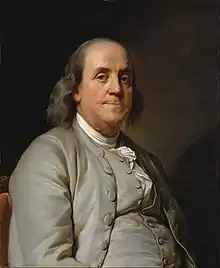
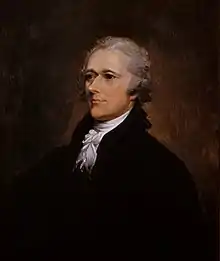
.jpg.webp)
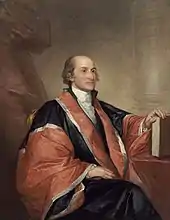

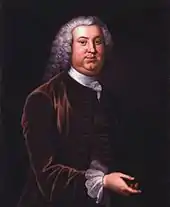



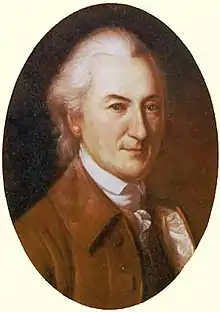
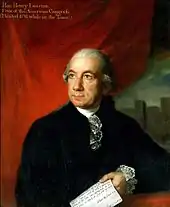
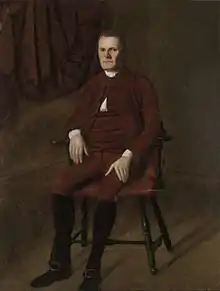

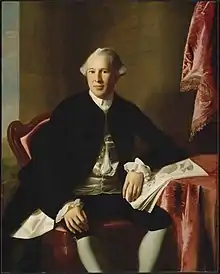
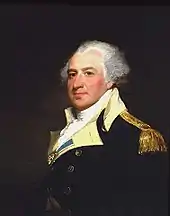
_-_1943.1816_-_Harvard_Art_Museums.jpg.webp)
